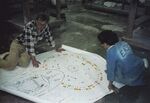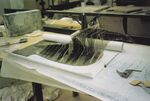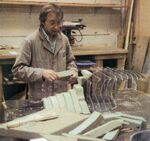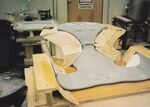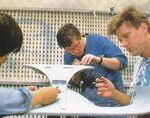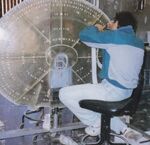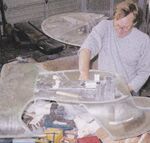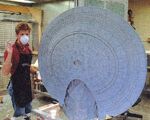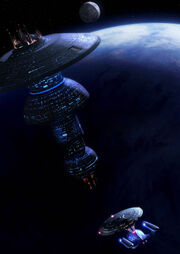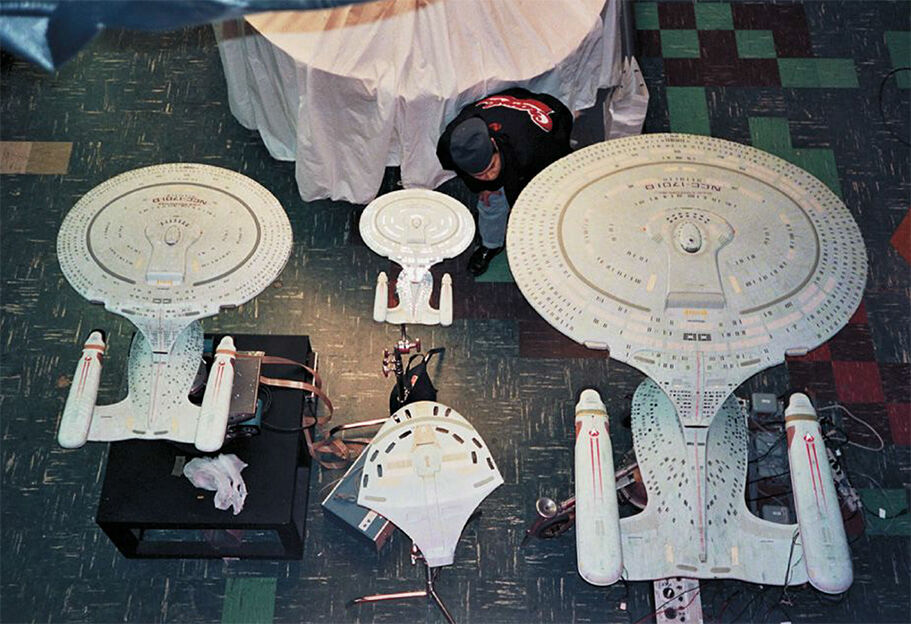
Several studio models of the Galaxy-class were created for Star Trek: The Next Generation, Star Trek Generations, Star Trek: Deep Space Nine and Star Trek: Enterprise. Two differently sized physical studio models were initially constructed for The Next Generation, to be joined by an intermediate sized one at a later stage. Advances in computer technology resulted in CGI model versions of the class being introduced, first in Generations, and subsequently during the run of Deep Space Nine for use in that series and beyond. Apart from these, several specialty models were also constructed of the Galaxy-class, or its components, to fulfill specific functions when the need for those arose due to specific script requirements. Various Galaxy-class models appeared in both the series premieres of The Next Generation and Deep Space Nine, and the series finales of The Next Generation, Deep Space Nine, Star Trek: Voyager, and Enterprise, making it the only Starfleet vessel of which external views were seen in all four spin-off television series, and the only one seen in all four finales.
Design
When it came time to design a new starship Enterprise for The Next Generation, history did not repeat itself. Where Matt Jefferies had to produce hundreds of sketches to come up with the design direction for the original USS Enterprise, the main design work for the exterior of the USS Enterprise-D was done long before another Star Trek television series had even been considered.
Design origins
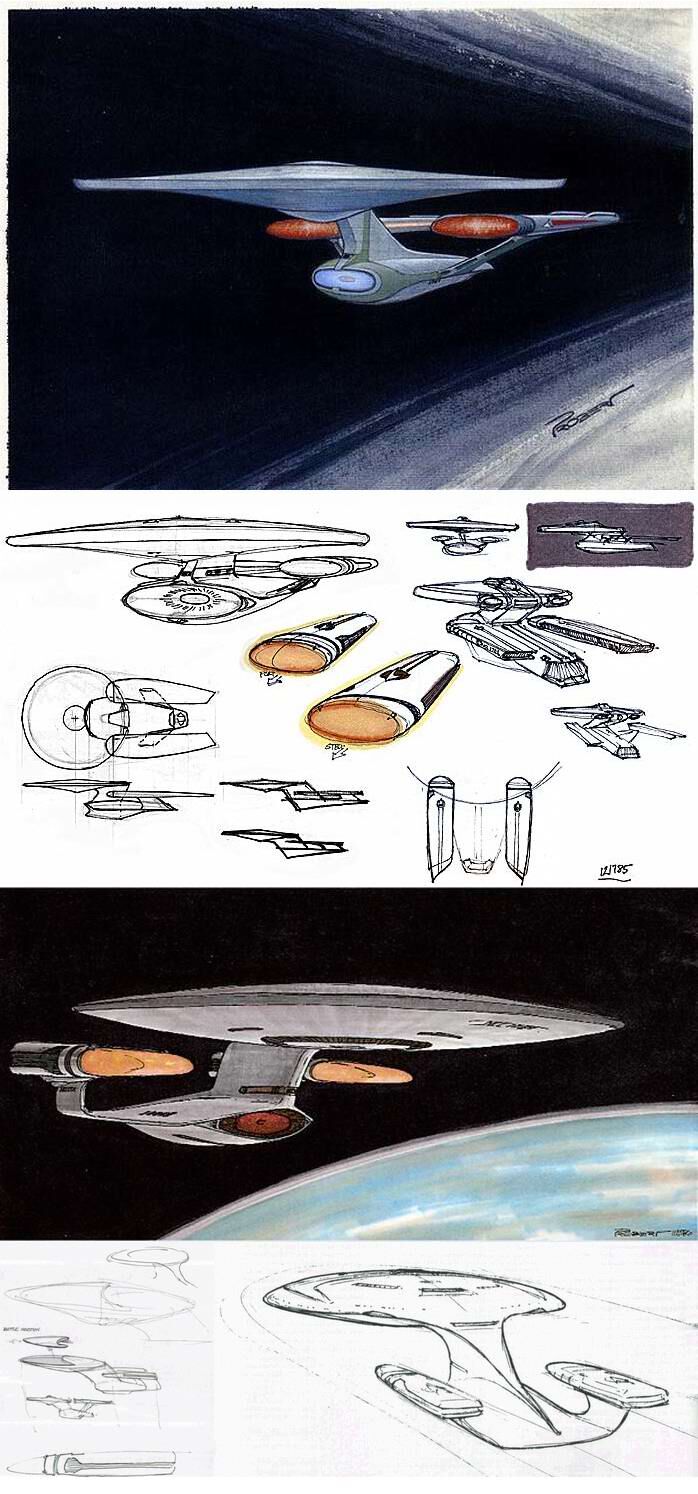
In 1979, long before the new Star Trek series was announced, Andrew Probert, upon completion of his work on Star Trek: The Motion Picture, painted an illustration of a future starship concept, strictly for his own enjoyment. "I actually did a little painting (8"×5.6") of a ship that would have been the Enterprise had I been able to take it fully in the direction I wanted to take it. That little painting became the basis for the Enterprise-D", he recalled. (Star Trek: The Next Generation USS Enterprise NCC-1701-D Blueprints, accompanying booklet, p. 7) Elaborating, he later added:
"Having warp engines above the saucer always bothered me and I thought it made more sense to lower them closer to the ship's center of mass. And, while I was at it, I thought, along with the saucer's wide horizontal profile, the other main elements should also be wide and horizontal. So I sat down and said... "what if..I could design this ship the way I thought it should look"?"
In December 1985 he shortly revisited that painting and made some additional sketches, still for his own amusement, "Six years go by and I randomly produce this page of sketches in one of my sketchbooks. Obviously, I started with that "New Idea" above and, out of the blue, sketched up these couple of ideas in passing, little realizing that I'd be doing this for real, less than a year later." [1](X) Probert later added:
"If you look at the original TV Enterprise, it had two long cylinders stuck to a stubby cylinder with flat sticks and a neck attached to a saucer, so you have many different design cross-sections. What I've attempted to do is unify the whole ship by giving everything the same sort of ovoid sculptural feeling, so it's basically an industrial design. After seeing the initial sketches, Gene and the other producers liked my idea. They actually played on it by rationalizing that in the future, our art forms will hopefully surpass our concern for technology. Therefore, we could design and build something that we were proud to fly around in; the technology being a given at this point." (The Official Star Trek: The Next Generation Magazine issue 4, p. 30)

Early November 1986, Probert secured an interview with Gene Roddenberry for a position on the new show. Going home after the interview, Probert was so excited, that he could not restrain himself from turning out a new painting and additional sketches of the new Enterprise based on his initial design six years earlier:
"I was so pumped up that I started right in, sketching my little heart out. Knowing that the new series was to be at least a hundred years hence (which later got changed to 85 years), I felt that it would be faster and probably sleeker if there was any influence from hyperlight dynamics. At least it should be more elegant, I felt. The saucer had, since its inception, been the main section, so I made it larger in proportion to the secondary or engineering hull. In previous designs the warp nacelles were always to the rear but above the saucer rim, which visually seemed to give them equal importance, and physically placed them above the ship's center of mass. Both of these seemed to be negative point, which I hoped to remedy by lowering them to a position between the two hull sections. This would place them closer to the ship's center of mass. Also, the struts holding the saucer and warp engines were slanted in opposite directions; the saucer is going forward, engines going back. That wasn't bad but it created a slight visual conflict, so I slanted them all forward to unify their direction and give the overall design a feeling of aggressive forward movement, like a lunging cat. The view from the front of the old ship produced a variety of shapes. I took my design theme from the saucer and started sketching every component as a compressed oval." (Star Trek: The Magazine Volume 1, Issue 16, pp. 50, 52)
Hired as the fifth member of the production team on 2 December 1986 in the capacity as Senior Illustrator, Probert's initial job was designing the interiors of the new starship, especially the bridge. As inspiration he brought along some of his sketches of the exterior of his vision for the new Enterprise and hung them on his office wall. While working on his bridge design, a lucky happenstance occurred when one of the producers walked into his office and saw one of his sketches, fondly remembered by Probert:
"David Gerrold walked in one day and asked, "Is that the new Enterprise?" I told him that it was the direction that I wanted to go with it. He leaned over me, plucked it off the wall and said, "Let me borrow this a minute," as he walked out. I don't think 15 minutes had passed when he returned when he returned with a smile on his face and said, "Yep, that's it, they liked it." As it turned out, Gerrold walked into Roddenberry's office while the other two producers were there, held up my sketch and said, "What do you think of this?" They all liked it.". (Starlog photo guidebook Special Effects, Vol.5, 1996, p. 100)
To which he added, "I was flabbergasted. I'd never heard of a design going through that quickly, and it was very close to what I ended up producing." (Star Trek: The Magazine Volume 1, Issue 16, p. 52)
All that remained was fine-tuning and filling in the details.
Refining the design


One of the first things Probert had to address was his misinterpretation of the saucer separation concept. Only referred to in the Original Series, this time around a saucer separation capability was from the very start envisioned for the new ship. The producers' idea behind this was, according to Executive Producer Robert H. Justman:
"(...) that we should have families on board. I said that it was unconscionable to expect people to go out into space for X number of years and leave everything they hold most dear behind them. Just because you're on a space exploration, it doesn't mean you have to give up your life. If you have loved ones, you have family, you should be able to enjoy and live and make your lives together, even though you're out in space.(...)For that we provided for the separation capabilities, so that in case of danger or threat to the ship as a whole, if necessary we would send the saucer section away under its own power. Not warp power, but sufficient power to get it away while the battle section went to the fight." (Star Trek: The Next Generation USS Enterprise NCC-1701-D Blueprints, booklet, pp. 10-11)
Yet a poor choice of wording in the preliminary briefing led Probert to misinterpret the producers' intent:
"The way they described it was that the Enterprise would have a battle section that would separate from the ship. I thought, 'Now you tell me!' I'm thinking, 'Hmm, a battle section that would leave the ship.' I thought maybe it was like an auxiliary craft or something that separated to go off and fight battles. What I came up with was a shape like the letter D. If you lay that down on top of the saucer with the round part toward the front and then extend the serifs, those would be two warp engines. This thing would be nestled into the top of the saucer and it would separate to go fight the battles. When I showed this to them they said, "No, no. What'll happen is the saucer separates and the engineering hull then becomes the battle section." So I have this dorsal sculpted into the saucer and now I have to separate that and still make it look good both ways, which was an extraordinary challenge. I started playing with it and I found if I left part of the saucer on the dorsal then it could be a very broad mounting point for the saucer as well as hopefully making the engineering hull look a little better." (Star Trek: The Magazine Volume 1, Issue 16, pp. 52-53)
Coincidentally, Probert's original concept of "an auxiliary craft or something that separated to go off and fight battles", was later re-visited in the design of the Prometheus-class.
Probert originally intended the saucer section to have landing feet, much like he had envisioned for his redesign of the Constitution II-class for Star Trek: The Motion Picture:
"Popular opinion indicated that the two triangular points on the underside of the saucer [remark: of the Original Series USS Enterprise] are actually two landing legs; the third one would be in the dorsal cavity, so the saucer would have tricycle landing gear for planet landing. Carrying that into Star Trek: The Motion Picture Enterprise I designed four landing pads on the underside of the saucer. When I did the D, I started to do that and was distracted away from it and that poor ship eventually paid the price!" (Star Trek: The Magazine Volume 1, Issue 16, p. 53)
Explaining some of the thought processes behind the fine-tuning process, Probert stated in regard to the vertical windows in the saucer section:
"They would scale out to about three and a half feet across and their length would vary according to what deck they were on. The way that I came up with that originally was that, if you think of a porthole on an ocean liner, it's usually set at an average height of around five feet, so any normal-sized person could look out of it. I started with that, but because the walls on the saucer are slanted at such a radical angle my thinking was, "Where do you put the porthole so everybody, short or tall, could look out?" The solution I came up with was to have a vertical porthole so people of any size could use it." (Star Trek: The Magazine Volume 1, Issue 16, pp. 55-56)
As to the armaments of the new vessel he elaborated:
"In classic Star Trek the phasers came from the Special Effects department. They had nothing to do with any feature on the outside of the original Enterprise. The phasers came out of the photon torpedo tube and vice versa: very confusing. When we did Star Trek: The Motion Picture, I felt it was important to give the effects animators as well as the audience an understanding of where the armament was on the Enterprise. So, I designed the bubble housings for the phaser banks. When it came to do Star Trek: The Next Generation, I started thinking about today's navy, particularly the Enterprise aircraft carrier, which has a reason for its square island and its four huge radar antennae that don't turn like the old radar antennae do. They're mounted to cover the four quadrants of the space around the carrier. And I got thinking that having little electronic turrets or phaser bubbles on the feature Enterprise was starting to look a little archaic. I thought it would be interesting to encircle vast areas of the ship with one single phaser strip, whereby the computer would be able to determine from a moving _target what would be the most optimum angle to fire at the _target. So if the Enterprise was passing a moving _target, the phaser beam would visually walk around the strip as the computer continually updated that angle of fire."
He added in regard to reducing the number of forward firing photon torpedo launchers from two to one, "I figured that advanced technology would allow a single photon tube to reload faster, plus it didn't make any bulgy things on the side of my dorsal." (Star Trek: The Next Generation USS Enterprise NCC-1701-D Blueprints, booklet, p. 8)

During the refinement stage, Probert, in conjuncture with Roddenberry, also worked out some basic specifications for the new ship:
"Roddenberry already liked the direction in which the Enterprise design was going and I took the opportunity to propose that we double the ship's length to 2,000 feet. Roddenberry thought that was rather large but after we talked about the extra personnel, families, holodecks, larger shuttles, longer missions, etc., he agreed. I added a series of visible lifeboat covers (as opposed to graphic markings on the movie Enterprise) to the ship which alluded to the ship's capacity of 3,500. He felt that too many extras (people) would be needed to reflect a complement of that many, so he established it as 1,100. Later on 1,012 became the official ship's complement." (Starlog photo guidebook Special Effects, Vol.5, 1996, pp. 107-108)
At this stage Probert shortly toyed with the idea of having his new ship a modular structure, before that was abandoned.

Gene Roddenberry asked only for two modifications to Probert's final design. He wanted to restore the bridge to its position on the top of the saucer section, which Probert had originally placed in the center of the saucer feeling "that in a ship that size, the bridge, being the center of command, should be in the center" and that "it would still have the electronic visual capabilities" with the added consideration that it would have been well protected. Roddenberry and Justman felt that the ship's defensive capabilities were able enough to protect the bridge no matter where it was placed even as exposed as it was on top of the saucer and they also wanted to allow viewers to be able to scale the rest of the ships in their minds. The other modification Roddenberry asked for was to extend the nacelles, which Probert had slanted forward in order to create the visual impression of a "lunging cat", so that they had similar proportions to the original Enterprise. (Star Trek: The Next Generation USS Enterprise NCC-1701-D Blueprints, booklet, pp. 7-8) The modification of the nacelles increased the overall length of the Galaxy class to 2,108 feet, as is adhered to in most reference works, among others the Star Trek: The Next Generation Technical Manual.
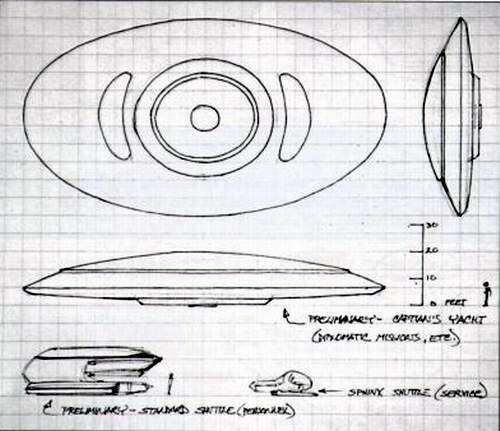
While addressing Roddenberry's requests, one of the last features Probert turned his attention to was the underside of the saucer section:
"In the original show the dome on the bottom of the ship was a sensor array. What I did was move the sensor array to more of a surrounding detail, leaving the dome on the bottom free. That's where I put the captain's yacht, which is a private vessel for dignitaries and captains of ships to use as personal shuttles. That was never used in the show. At one point there was a script where Picard was returning to the ship and the dialogue was, "The captain's shuttle is on the way back. Crew members, man your stations." Then the captain comes aboard. We never ever have a visual, so I suggested mentioning the yacht, but they decided against it." (Star Trek: The Magazine Volume 1, Issue 16, p. 55)
Though the concept of an embedded captain's yacht was further explored in the Next Generation Technical Manual, in which the vessel was christened Calypso and was also envisioned to be a feature on the USS Voyager in the form of the Aeroshuttle. The concept was only firmly established in Star Trek: Insurrection on the USS Enterprise in the form of the Cousteau.

After final approval of the design a set of six-view orthographic working drawings were made to be sent to the outside contractor that was to build the studio model.
A design patent, No. D307923, was issued to Paramount Pictures by the US Patent and Trademark Office for the USS Enterprise-D on 15 March 1990 (there described as "The ornamental design for a toy spaceship"), which noted Andrew Probert as the sole "inventor", correctly in this case, of the design. Probert's earlier patents for the starships in The Motion Picture were cited as past references, as was the USS Reliant. The patent application was tendered by the studio on 23 September 1987, valid for fourteen years when issued.
ILM and study models
Once the design phase for the new Enterprise, to serve as the main vessel for the new The Next Generation series, had become final, tenders got out to solicit bids in order to build two studio models. "Once we got all the working drawings for the exterior of the ship, I put up it out for bids to a number of optical special effects houses, including Industrial Light & Magic (ILM), Apogee, and DreamQuest. All of them received copies of the main title sequence and a list of library shots which we would need for various episodes. Of the five we contacted, four were in the Los Angeles area; only ILM was out of town, up in Marin County.", Justman recalled. (Star Trek: The Next Generation USS Enterprise NCC-1701-D Blueprints, booklet, p. 9)
Yet, ILM was able to secure the commission, due to the fact that they were able to tender a bid that was below par as the company was between jobs. "'What they decided was to make a bare-bones bid, enough to keep their doors open and keep everyone on that they needed. Oh, it was a tremendous bid. I couldn't believe it was so cheap! But it was ILM, you know? The best in the business!", Justman exclaimed. (Star Trek: The Next Generation Companion, 3rd ed., p. 12)
Still, no matter what deal was offered to the company, Model Shop Supervisor Jeff Mann had to contend with differences between the franchise's movie productions and TV productions:
"In the past, we had always dealt with the movie division – people like Harve Bennett and Ralph Winter – but this was a whole new group of people working on the TV series and they weren't familiar with our involvement in Star Trek movie FX – that is, what we do and how we do it. So, the new producing team came up and we had a show and tell session. We got out all the Star Trek movie models so they could see what they looked like close up, how they were built and how they operated. In this way, we were able to give them an idea of what different things cost. I'm sure they went through a similar process for all of the companies that they visited for FX bids.
"Of course, everybody does things slightly differently, we all have our own methods and systems. For us, it was an education process to determine the producers' needs and discuss how they were to be satisfied. At that point, the only thing under discussion was building the ship. We would not be shooting it. Our bid was based on the very specific requirements that Andy Probert's ideas would be interpreted exactly – we were to build that ship as drawn.
"This was a very different way of working for us, and in a way, harder. I think our real strength at ILM is art direction and the interchange of ideas as a project develops. When working with David Carson, Nilo Rodis-Jamero or Joe Johnston, for example, as art directors, they'll have an idea which they sketch out and one of us may come back and suggest that we need to twist this a little bit, or how about something more like this... It's very much a collaborative process.
"But the Star Trek people had already nailed down all of their ideas and concepts for the Enterprise, and Andy Probert was very knowledgeable as to why certain features of the Enterprise are the way they are. It wasn't just a matter of pretty design, his detailing is very functional." (The Official Star Trek: The Next Generation Magazine issue 2, p. 28)
 |
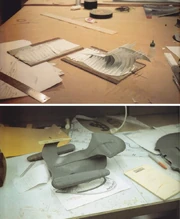 |
 | |
Once ILM was chosen, the producers sent the company the orthographic drawings they had prepared. It was up to Gregory Jein, employed at ILM at the time, to come up with a concept model to show if the intent was understood. A clay study model was presented to the producers and it was then that Probert realized that orthographic views were not sufficient and a more hands-on approach was needed. "The first thing that they had sent us was a two-foot maquette based on the drawings that we had sent up. The only thing that I had guessed wrong, in defining the shape of the ship from six views, was the shape of the wing as seen from the top and bottom. I felt the most important profile was the side view. Looking at the wing top or bottom produced a different wing shape than seen from the side.", to which Jein added, "Once we got the drawings and the approval, after all the bids from all the other companies came in, ILM got the contract. Jeff Mann was the head of the model shop at that time, and I was the lead man on the patterns. So we just interpreted Andy's drawings as best as we could.". (Star Trek: The Next Generation USS Enterprise NCC-1701-D Blueprints, accompanying booklet, p. 9) Doug Drexler remembered seeing the study model after he was hired on the show: "Bob had just gotten done showing me Greg Jein's little five inch maquette of the Enterprise-D. It was the first time I laid eyes on the new configuration. I remember all the little windows being penciled, and I remember Bob's obvious pride in the design. "Not a straight line on it," he enthused, referring to the ships curvy appearance. Curves meant that the show had a substantially better budget than in 1966." [2](X)
Adopting the hands-on approach from then on, Probert kept in very close contact with the model shop of ILM during the build of the two models. A second clay study model was commissioned (constructed around a carton skeletal structure for internal integrity), this time as a two-part model to reflect the saucer separation capability. This time the model followed more closely the lines of the ship Probert had in mind. By the time the model was delivered to the producers, construction on the larger studio model had already started. (Star Trek: The Next Generation - The Continuing Mission, pp. 18-20) Again built by Jein, this version was presented in person by an ILM representative to Roddenberry at his Paramount office for his approval, after which the model was used by John Knoll to test out his below-mentioned "slit-scan" technique. Not seen for decades afterwards, the study model resurfaced in the collection of ScienceFictionArchives.com, an European organization that is dedicated to preserve science fiction production assets for public display purposes, such as in museums. [3] The whereabouts of the first concept model though, remain unknown.
Once given the go-ahead, a second set of one-to-one scale working drawings of the six-foot model were prepared and sent to ILM, and from then on the model-shop was on a tight schedule. "They called us on a Friday. They said, "OK, we accept your price to build the ship; we want you to start on Monday and build it in 10 weeks." I said 12 weeks. I knew what it took to build other ships, and I knew that this one would be more difficult.", Mann remembered. (The Official Star Trek: The Next Generation Magazine issue 2, p. 30) First order of business for Mann was composing the team that was to build the two models. As lead modelers he chose Greg Jein (as pattern or master lead) and Ease Owyeung. The team was further filled out by Sean Casey, Bill Concannom, Bill George, Wesley Seeds, Larry Tan, and Howie Weed, while Steve Gawley was given the task of preparing the Excelsior-class studio model, for its re-use. (The Official Star Trek: The Next Generation Magazine issue 2, pp. 31, 40)
Six-foot model
Awarded the contract to build two differently sized physical studio models of the Enterprise-D for the new The Next Generation television show, ILM faced some problems where the larger of the two was concerned, the one that was to be known as the "six-foot model". As Model Shop Supervisor Jeff Mann recalled:
"The principal difficulties with this model were: First, this Enterprise has a detachable saucer; and second, the shape is very flat, which makes it difficult to mount – that is, the center-of-gravity was positioned so that it couldn't be supported easily. Also, when you have someone specifying the paint scheme and windows so very specifically, as Andy Probert did, it takes much more time – you have to be very careful and plan things out. "The ships we did for the Star Wars movies were much looser. The art director would say that he wanted this kind of a look with this paint job and panels. We have a way of detailing the ships with a team of guys – sort of like a quilting bee. Using airbrushes and pre-etched brass stencils, we move around the ship in a somewhat random pattern. It's like an impressionistic painting when you stand back, turn your head sideways and squint. It works. It's very subtle and it helps the scale." (The Official Star Trek: The Next Generation Magazine issue 2, pp. 30-31)
Build
After receiving large one-to-one scale orthographic working drawings for the six-feet model from the studio, construction started on Monday 2 March 1987. First thing to be addressed was the solving of the center-of-gravity challenge, which Owyeung had to tackle in the manufacture of the machine shopped aluminum armature framework. Mann explained:
"The armature was really a difficult problem, which had to be solved right away, because, of course, everything is built around the armature. The old Enterprise has a nose mount in the center of its body – no mounts are on the dish, but right about the center of gravity, there are mounts going out each side and the bottom and the rear, The new Enterprise is generally a flat ship since the engine nacelles don't stick up and the saucer is elliptical; the ship is very nose heavy because of the enormous elliptical dish, which puts the center of gravity somewhere up in the neck and dish area. We had to come up with a a really complicated armature that would allow us to shoot the ship from all positions – both together and then split apart, because this new Enterprise is essentially two ships. In concept, we would be dealing with 12 mounting points.
"Ease came up with a pretty simple method that involved mounting the dish on the top or bottom and making the armature strong enough so that even if you grab it at one end with the other end of the ship just cantilevered, it would still hold. On our other ships, the saucer has an edge which is about two or three inches thick, so it would be possible to pop a panel off and run a mount arm in. But on this design, the saucer tapers down to almost a point – maybe a quarter of an inch. To run a mount arm in, we would need to do much more than pop in a panel, we would have to take a section out of pie out, and then we couldn't shoot the model from the top or bottom.
"Ease designed a mount arm that emerges out of the dish's top or bottom and makes a right turn, it is structurally sound enough to support the entire ship – and this [is] the heaviest ship we ever built. There is another mount at the neck and others at the bottom, the rear and the front of the body. So, I guess there are six different mount points that allow you to shoot from any direction." (The Official Star Trek: The Next Generation Magazine issue 2, pp. 31-32)
In the meantime, while Owyeung was solving the question of the structural integrity of the model, Greg Jein turned his attention to the manufacture of the masters or patterns of the model from which molds were to be taken for the casting of the parts, that were to be used to construct the final model. Mann elaborated further:
"Jein's basic approach was to use station points on Probert's drawings to create sectional ribs out of Plexiglas. Styrofoam was used to to fill in the gaps and Bondo was laid over the surface, It took a lot of hand work to sand down the Bondo down to the ribs. "For the elliptical dish we had a side view and a front view, but everything in between wasn't drawn. So, we got the computer graphics boys in, which we thought would be a really fast way to get the sectional views we needed. But it turned out that their schedule and ours wouldn't work out. Greg said, "I'll do it!" and he came up with a way of shortening each rib – he must have made at least 100 of them, and he had to do it for the top and the bottom of the saucer."
To which Jein added, "My main concern was getting the shell to the right contour. On my first attempt, I thought I could get by with fewer station points, but the curve was so complex that the shape began to dip. On the second try, I made enough station points so that it was practically a solid mass front to center. I filled in the rest with rigid polyfoam and finished off the surface in Bondo, which was sanded down to the Plexiglas station points." Once sculpted, the master's surfaces were imprinted with details or, as Jein put it:
"If you're going to the trouble of creating a pattern, taking a silicon mold and making casts in fiberglass resin, every casting should come out of that mold relatively finished, rather than casting a simple shape and having to detail every casting. Once it was formed and shaped, we used a mixture of Bondo, glass cloth and polyester resin to harden the surface. Then, when we got this nice smooth surface, we laid down Letraset tapes in three smallest gauges in a cross contour all over the ship's surface. Once the tape was down in a position we liked, we sprayed the model with an automotive primer and peeled it up before it cured, thereby leaving a depression in the paint. It's like a reverse stencil; it allows us to make corrections by just moving the tape, rather than inscribing into the model and having to correct that." (The Official Star Trek: The Next Generation Magazine issue 2, p. 32)
After Jein's team had applied all the tapes onto the master and inscribing additional details into it, mostly to indicate where all the windows were to be positioned, liquidized silicone rubber, after an intermediate process to stabilize the master, was poured over the master. After solidifying the rubber was pulled off the master, resulting in a negative mold. These molds then served as a tool into which heated glass reinforced plastic was poured. Vacuformed, i.e. the air sucked out of the space between the mold and the plastic to achieve a perfect fit, this eventually resulted after cooling off in a cast, once the flexible mold was pulled off, to be used to construct the final model with. The resin chosen was transparent, as after application of the paint layers, details such as the windows then could be showcased by merely scraping away the paint layers and/or removing the masking tape on those applicable places where the internal neon lighting was supposed to shine through. (Sci-Fi & Fantasy Models, issue 29, pp. 52-53)
Establishing the color for the Galaxy-class

As the build of the six-foot model was nearing its completion, Probert turned his attention to giving the model its color, like his predecessor Jefferies had done with the original Enterprise. Probert had a specific goal in mind when deciding upon the color scheme, "When I did the Enterprise-D, in my attempt at easing the visual move into a new shape Enterprise, looking [at] a lot of footage of classic Star Trek and all of the Enterprise flybys, I specified the color to be very subtle shades of blues and greens." (Star Trek: The Next Generation USS Enterprise NCC-1701-D Blueprints, booklet, p. 8) Probert's intent was to approximate the bluish hue as it was seen on screen in the original run of The Original Series:
"The fans were very concerned that we were replacing the original series. In order to soften some of that anxiety I wanted the two ships to be colored basically the same. Well, because of the low degree of technology compared to today, when the original Enterprise (which was actually a warm pearl gray) was filmed it picked up a lot of the blue spill [light used in the visual effects process] and therefore became bluish. What I did was indicate that the paneling of the D be painted in two shades of blue. One is a duck egg blue, and the other is kind of a sky blue, which is the base color the hobby kits are molded in. By mixing the two blues together I was hoping cinematically that there would be a close tie-in with the color of the original ship." (Star Trek: The Magazine Volume 1, Issue 16, p. 56)
The paneling Probert referred to was the re-introduction of the "Aztec-paneling", the interlocking hull plate pattern on the saucer section originally conceived for the Motion Picture Enterprise in order to ease some of the concerns as worded by later appointed Visual Effects Supervisor Dan Curry: "But when we photographed the big ship very smooth, we couldn't tell the difference between it and a very small ship very smooth, because photographically, particularly on television and in order to create that sense of scale and hugeness, we needed three-dimensional relief, something to cast shadows." Eventually Curry's concerns were only partially met due to time restraints. He further recalled:
"On the six-foot model, another two months would have gotten us the detail I wanted, but I had to be practical. We had to get the model photographed and into the show. Although the use of the blue and green paneling worked well, I also asked for more "weathering", to make the surface more believable, even though we're reasonably sure that there's no weathering in space, no grease stains, no oxidation like you would have have on an airplane. When you have a completed model like that and it's painted and it looks pristine, it's not believable because it's pristine. It needs a certain patchiness to it, and the more detail you can get into a miniature, the more believable it's going to look" (Star Trek: The Next Generation USS Enterprise NCC-1701-D Blueprints, booklet, p. 9)

The "hobby kits" Probert referred to was AMT/Ertl model kit No. 6619 that was released within a year of the show's first airing. AMT, for whom Probert concurrently served as a consultant [4], maintained close contact with the Art Department as their painting instructions proved to be highly accurate. A pre-production evaluation model was sent to the studio and ended up as display piece in various episodes (see below). How close this contact was, was evidenced by the fact that they unwittingly copied an in-joke one of the modelers performed on the studio model. Detailing the numerous panels onto the model was drawn-out and tedious work, and one of the modelers, no doubt in a mood of tediousness, arranged some of the panels to read "Ugly". Never discernible on screen, it was dutifully carried over onto AMT's instruction-sheet. (Sci-Fi & Fantasy Models, issue 29, p. 54)
Probert has given a detailed overview of the colors he has used on an archived version of his website(X), specified as follows:
| Galaxy-class color scheme | |||
|---|---|---|---|
| Part | PMS[1] | Federal Standard[2] | FS sample |
| Hull Green (paneling) | 565 | FS-24516 |  |
| Hull Blue (base) | 290 | FS-15526 | |
| Navigational deflector Dish | 166 | FS-22246 | |
| Navigational deflector Housing | 154 | FS-10115 | |
| Lifeboat Covers | 413 | FS-36595 |  |
| Sensor Strips | 278 | FS-35450 | |
| Shuttle Bay Decks | 430 | FS-36270 | |
| Phaser/Photon Housings | 423 | FS-36307 | |
| Phaser Banks | 455 | FS-34201 |  |
| RCS Housings | 616 | FS-23564 | |
| Hull Lettering Blue | 281 | FS-25065 | |
| Insignia, other graphics, red | 186 | FS-21105 | |
| Front End-Caps | 159 | FS-22203 |  |
| Engine (serrated) Neck | 130 | FS-33538 | |
| Coil Gaps (between) | 542 | FS-35231 | |
| Power Coils | Metallic Copper | - | - |
- notes:
- ↑ Pantone Colors
- ↑ Color samples courtesy of Colorserver.net
When Probert saw the first footage of the model shot under studio conditions, he was surprised that the result was the exact opposite of what he had intended. The intense studio lights blurred the color scheme into an overall gray color (as it did when still-photographed with flashlights; – see picture below of the "anti-time" variant of the four-foot model), ironically making the model approximate the appearance of the original Enterprise model as it was under flat-lit conditions. Though to date, no production confirmation has ever been forthcoming supporting the assertion, Probert has always been under the impression that this had been done on purpose. "For some unknown reason, however,... those colors were intentionally neutralized when the miniature was filmed, reducing it to the ranks of yet another gray spaceship. And this dis-coloring was perpetuated in subsequent movies." [5](X). Nevertheless, this color scheme has been adhered to for the remainder of the series and has been carried over to the later four-foot model as well as to the contemporary Nebula-class studio model.
Production use
 |
 |
 |
Upon completion, the model, measuring 78 × 59½ × 14½ inches, was retained at ILM, as the company by that time had secured additional rights to shoot stock footage, especially Motion control photography, of the model and the going-to-warp sequences for the pilot episode "Encounter at Farpoint". The model was delivered on schedule, "(...)and we actually started shooting the ship on June 1.", newly appointed Visual Effects Supervisor Robert Legato confirmed (Starlog, issue 132, p. 55). Usage was made of the six-feet model since then, in providing additional stock footage at Image G until the advent in 1989 of the four-foot model in "The Defector", though the stock footage shot up until then was utilized throughout the remainder of the series. As the production staff had decided upon a relatively small class of only six vessels in service, no other Galaxy-class vessels were called upon to make an appearance during the run of TNG, with the exception of the USS Yamato (NCC-71807), which was represented using stock footage of the Enterprise-D. The Star Trek: Encyclopedia mentions that Michael Okuda made decals for the Yamato for its appearance in "Contagion", but it is unclear whether the six-foot model was relabeled or if the decals were created for the debris seen in that episode. (Star Trek Encyclopedia, 3rd ed., p. 569)
 |
 |
Less than a year later, in 1990, Robert Legato's visual effects team was forced to pull the six-foot model back from retirement for use in the season four episode "The Best of Both Worlds, Part II". The script specified that the Enterprise-D performed a battle maneuver that involved a saucer separation for which stock footage was not sufficient and the large model was the only one that was constructed to do so. Having quickly become accustomed to the easier to handle four-foot model, which was on top of it also outfitted with an easier to operate lighting rig, the team was less than enthusiastic of having to work with the larger, more unwieldy six-foot model again. Having to handle the large model again, "(...) proved to us what a pain that model really was to shoot.", an evidently terse Legato commented. (Cinefantastique, Vol 22, issue 2, p. 34) Legato was not alone in his assessment. Close co-worker, Visual Effects Coordinator Gary Hutzel, had issues with the model too, as he reminisced in 2012, "The original 1701-D Enterprise, which we received from ILM, they constructed at ILM, was a very sophisticated model for its time. My understanding was it cost approximately $75,000 to have constructed. It had very complex internal lighting systems and very elaborated animated elements in the foreground nacelles and all that. When we received it, the first thing that struck was that it was gigantic. The saucer was an oval, so it was very wide, it was made of fiberglass and aluminum framing, and it was constructed in such a way that the saucer could separate from the main body. So, it was a very, very heavy model. It took anywhere between four and six people to pick of off its stand and reorient it for any of the shots we had to do. So, it was very, very heavy and in addition it was very complex. It had fourteen separate, high-voltage neon light circuits in it, which I had to rig every time we had to shoot it. And I wish I had a dime for every time that sucker shocked the bejeebers out of me when we were going to plug it in, or unplug it, because we get an arc from that high-voltage source." (TNG Season 3 Blu-ray-special feature, "The Trek Not Taken")
 |
 |
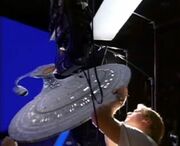 |
Four years later, the services of the six-foot model were called upon yet again for appearance in Star Trek Generations. The only other alternative, the four-foot model, was not an option as it was too small for the big screen and was still in use for television productions. Most importantly, it was not capable of saucer separation and the script for the movie required one. When hauled out of storage and delivered to ILM, it became clear that the model needed a refurbishment to meet big screen requirements. Visual Effects Art Director Bill George, who was part of the original construction team seven years earlier came full circle, when he again had to work with the model:
"I have to admit, when I first saw the Next Generation's Enterprise, I didn't like it much, but it has definitely grown on me. I view most of the Star Trek ships as Art Deco – they're very simple shapes put together – but I think the Next Generation ship is more Art Nouveau. Quite frankly, it was a very difficult model to build because of that. It's definitely the next stage, and it's more organic. There are some things I've always wanted to do to that Enterprise, but Rick Berman just wanted us to give it a facelift. I wanted to change the paint job, because we didn't have a lot of time to paint it when we built the model back in 1987, and the green and blue color scheme didn't read on television. Rick agreed, since the six-foot model was pretty beat up. We stripped off all the paint and decals and Bondoed all the dents and scrapes where the motion-control camera had run into it. We took the color more toward a battleship grey, and also, per John Knoll, added some glossy areas because he liked the tiled look of the original Enterprise. When there's raking light across it, you can see that paneled look and it's really beautiful." (American Cinematographer, January 1995, p. 79)
Once Berman came around to his way of thinking, George added, "Rick said that people who watch the show have fallen in love with the Enterprise, and when they see it in the theater, they should fall in love with it all over again." With regard to the glossy highlights which so bedeviled camera teams in filming The Motion Picture Enterprise, George clarified, "Now that we've entered the digital realm, we don't have the same enormous problems we once did with blue spill. John Knoll felt that adding these glossy areas – where there would be glints of reflected light – would really help the scale. Embellishments, such as the accentuation of numerous emergency "lifeboats" visible in relief along the hull and scale graphics identifying each of them, provided additional detail." (Cinefex, issue 61, p. 70)
Replacing the paint scheme was not the only thing that had to be tackled. Years of storage had taken its toll as Model Supervisor John Goodson clarified:
"I think there were an average of about three people for about twelve weeks to refurbish this model. We took the thing completely apart and replaced a lot of the missing neons or neons that were broken on it, rewired the engines, went into it, did a lot of cosmetic body work to it. It was like an old car when it showed up. It had a lot of things that were broken, the front of the engines were falling off, the impulse engines were gone. We did a whole new paint job on it, which was about two months worth of painting, because we kept masking and masking and masking. We actually kept all the masking tape of it, and it ended up as a ball this big. [Goodson spreading his arms wide to indicate the size]" (Star Trek Generations (Special Edition) DVD-special feature, "Inside ILM: Models And Miniatures")

Despite considerable efforts of ILM to outfit the six-foot model with a new livery, unexpected reuse of stock footage of the model originally shot for "Encounter at Farpoint" turned up in Generations. The first use was an establishing shot just prior to the scene in stellar cartography, while the second was a view of the underside of the ship during the saucer separation. As the model had been refurbished for the movie, its use constituted a continuity breach. "This created a problem later on, when Berman & Lauritson decided to save 12 cents and reuse a stock TNG flyby from the pilot for Generations (right before the Data/Picard cartography scene) ...for that shot, you've got a very old ship element that they had to tweak like crazy to get it looking like the repainted D, not all that successfully. And it wasn't even ILM who recomp[osit]ed that shot, it was Jeff Matakovich (sp?), who did it as an optical, not a digital comp.", Kevin H. Martin (author of the feature article in Cinefex) recalled. [6](X) When interviewed by Martin, Visual Effects Supervisor Ronald B. Moore justified the decision, "The production decided to reuse a couple of stock Enterprise-D shots from the series. It was a matter of time and money; but, in truth, there was no reason not to use them. So we dug up some shots ILM had done for the pilot episode. They were generic shots, and we had comped them a lot of times. We considered the recompositing of these shots on the computer, but since the elements had been shot Vistavision, I suggested that we have them done optically by Jeff Matakovich at Optical Illusions." Admitting there was more work involved than originally envisioned, he continued, "The film had more weave and motion than we liked; so, very quickly and economically, Jeff made cover mattes and assembled the comps." (Cinefex, issue 61, pp. 69-70) Nevertheless, it constituted the very first time that Probert's carefully laid out color scheme became somewhat discernible on-screen, years before the later The Next Generation remastering efforts.
Its use in Star Trek Generations, proved to be the last time the six-foot studio model was ever used as a production asset. The shot of the saucer section breaking through the cloud cover of Veridian III was the last shot of the model seen in a Star Trek production.
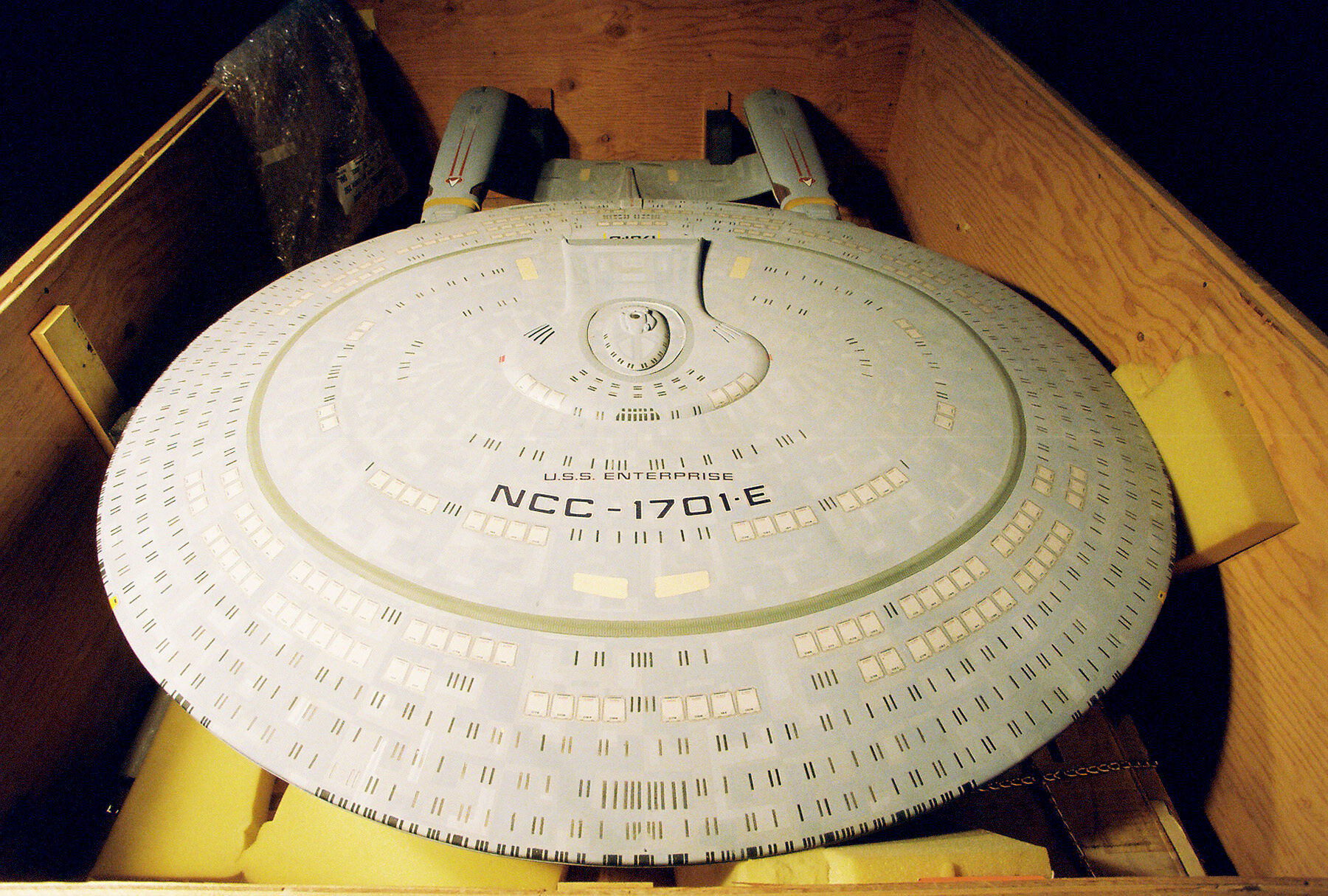
After shooting, the model for Generations had been modified to have the registry read "USS Enterprise NCC-1701-E". It befuddled Penny Juday, then archivist at Paramount Pictures, who had no explanation for this change as she uncrated the model for the TNG Season 2 DVD-special feature, "Inside the Starfleet Archives" on 19 October 2001. However, the change was done at ILM by Goodson prior to crating up the model after completion of Generations. He assumed that the new Enterprise might be a Galaxy-class ship as well and changed over the number to save whoever would do the special effects the trouble of having to change it over themselves. (Industrial Light & Magic: Into the Digital Realm, p. 60)
Post-production use
 |
 |
Relabeled back to "NCC-1701-D", known as Lot 712(X), part of the 40 Years of Star Trek: The Collection auction and estimated at US$25,000-$35,000, the six-foot model was eventually sold on 7 October 2006 with a winning bid of US$500,000 ($576,000 including buyer's premium). The model, still carrying the battle damage scars applied at ILM for its last appearance, eventually became the highest priced lot of he auction. Incindentally, when taking the undisclosed seller's premium for the sevices of the auction house into account, this actually constituted pure profit (roughly an inflation adjusted gross profit of US$190,000 in 1987 prices) for the franchise as the model, constructed at the above-mentionded cost of US$75,000, was completely written off as a production asset.
The model was acquired by Microsoft's co-founder Paul Allen for his Science Fiction Museum and Hall of Fame in Seattle – now known as the Museum of Pop Culture (MoPop) – , [7] though it was initially not put on display due to space limitations in the museum. It eventually resurfaced as part of the Star Trek: Exploring New Worlds exhibition, when it was displayed at MoPop from 21 May 2016 to 28 May 2018 [8], becoming subsequently a touring exhibition. [9] [10] [11]
Two-foot model
Fully aware of the fact that the six-foot model was to be a large, hard-to-handle model, the producers, taking a cue from their predecessor, decided to have ILM build a smaller two-foot model of the Enterprise-D as well for the new The Next Generation television show, for forced perspective shots where detailed views were less of an issue.
Build
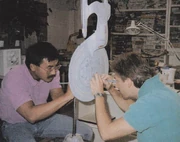 |
 |
Because of this, the small model needed less detailing, less elaborate lighting, and also did not need to be capable of saucer separation. This made it easier to build for the crew, who followed essentially the same building methodology as with the six-foot model. Unlike its predecessor, the three-foot Constitution-class studio model, which was originally only intended as study model and for public relations purposes, the two-foot model was from its very inception intended to serve as a full worthy filming model. It was therefore outfitted with internal lighting, though that was limited to the warp engines, navigational lights and deflector dish. As for the windows, Visual Effects Associate Eric Alba has observed, "This model is different from the 4 and 6 footer in that there were no electronic lights built into the windows. Rather, 3M reflective tape was placed where windows were and were illuminated with a simple lamp. [12] Michael Okuda later added in this respect, "I should clarify that while the 2' Enterprise didn't have interior window lights, it did have little bits of retroreflective tape for the windows. This ingenious technique wasn't as effective as internal neon lighting, but it did allow for the illusion of internal lights on models that were too small for neon. The glow from retroreflective tape (like the lettering on many highway signs) was often dimmer and sometimes did not show up well in the original video composites." [13]
Reportedly, the construction costs for both the two-foot and six-foot models, came in at around US$75,000. (Star Trek: The Next Generation Companion, 3rd ed., p. 12) Two internal memos from Associate Producer Peter Lauritson, one dated 1 April 1987 were the costs were stated to be US$72,750, and one dated 12 May 1987 where they were adjusted upwards to US$73,663 ($77,479 including tax), gave an impression how the costs developed. [14] As a comparison, the single Motion Picture Enterprise model constructed nine years earlier came in at double that price.
Use
Upon completion, the model was turned over to ILM's David Carson's film crew for filming the intricate "going-to-warp" sequences in conjuncture with the big model. Additional footage was shot at Paramount Pictures for the pilot episode and at Image G afterwards, until the advent of the four-foot model early in TNG Season 3, after which the model was retired though stock footage remained utilized throughout the remainder of the series.
One way of distinguishing the two-foot model from its larger counterpart, at least in the more static shots, were the front, port and starboard running lights on the saucer. These were far more pronounced on the smaller model, as the light bulbs used were large in relation to the scale of the model. Apart from this, there was less overall lighting, especially on the ventral side of the saucer section, partly for the technical reasons as touched upon by Michael Okuda. For the remastered version of The Next Generation, some of these deficiencies were corrected (see below). Okuda clarified, "Today's digital compositing tools offer more flexibility, so are sometimes able to pull more detail out of the tiny retroreflective windows." [15] The remastered version has also made it easier to discern the pronounced separation lines between the saucer and secondary hull, which were far more pronounced on the six-foot model due to that model's two-part construction.
A notable appearance of the two-foot model occurred in "11001001" in the scene where the Enterprise-D approaches Starbase 74. Explaining the scene from a cost-saving point of view, Robert Legato related: "One week the Enterprise was supposed to visit a space station, so we constructed it around stock footage we have access to. We took some footage from one of the four features and used the background with the space station in it. We then matted in the new Enterprise, following the exact movement of the old Enterprise. So it had a lot of production value, but what it cost was the expense of compositing those shots as opposed to building a space station and setting up the shot from scratch. You use what you got, and disguise it a bit. We do that quite a lot." (Cinefantastique, Vol 19, issue 3, p. 33) Image G's Tom Barron, delving a bit deeper into the technological aspects of the scene, elaborated:
"For one episode, we had the new Enterprise fly into the background footage drydock used in Star Trek III: The Search for Spock – and what we wound up doing was running a tape of the movie and matching the moves and angles of the old ILM shot by using split screen comparison mix. We matched the interactive light as well. Like everything else, we shot the moves on half-inch JVC video recorder and then ran the tape over to Rob and Dan who gave us suggestions and approval." (Cinefex, issue 37, p. 21)
 |
 |
 |
The creative use of this stock footage did not meet everyone's approval as Probert's later observation showed:
"Going into the Spacedock was ludicrous, and I was fighting tooth and nail to get them to not do that. The producers simply shrugged their shoulders and said, "Well, we'll say it's a bigger Spacedock," but that logic really didn't work for me. The system that I proposed was that the Enterprise to be serviced and docked on the existing space station' exterior, because it has an umbrella-like rim – a mushroom head, if you will – under which the Enterprise could have been docked by connecting the dorsal replenishment systems, but... There's a lot of things that sort of fell by the wayside, and it is what it is." [16]
Probert eventually produced a matte-painting that was used to show the Enterprise-D docked inside Starbase 74. At Image G a close-up shot was taken of the six-foot model, combined with a maquette of the gangway, which was especially constructed for the occasion. The shot was printed on a plate and sent to Probert, who produced the interior of the station and incorporated the ship plate in his painting, adding touch-ups on the ship and gangway. Footage of people walking through the gangway as well as the addition of a passing shuttle drone were added in post-production. [17](X)
The current wherabouts of the two-foot model are unknown. Unlike its larger counterparts, it has not yet appeared in any auctions or exhibitions.
Filming the six and two-foot models
Originally only contracted to build the two studio models, ILM was able to secure an additional commission to do visual effects photography for the pilot as well including shooting effects shots of the Enterprise-D model(s). David Carson remembered, "They sent us a tape of clips of the old TV show, about 40 of them, different fly-bys: bank left, bank right, comes close, goes far away, etc. They pretty much covered their needs. Their intention was to draw from this library of basic shots wherever appropriate throughout the 24-episode season. Elements we shot could be matted into a variety of backgrounds which could either be pulled from the features or new backgrounds to be produced." (The Official Star Trek: The Next Generation Magazine issue 2, pp. 28-29)
Going-to-warp sequences
The first order of business was getting the going-to-warp sequence of the new starship for the title sequence of the new series on film, as envisioned by Robert Justman. In a final proposal to Roddenberry, he worded the main title sequence as "As narration finishes, the warp engines suddenly glow brightly and the Enterprise hurtles away from us, accelerating into warp speed. The ship seems to stretch longitudinally in a kind of "rubber band" effect as the forward part of its image pulls away from the rear part. A beat later, the rear part of the image snaps forward and rejoins the part." (Star Trek: The Magazine Volume 1, Issue 5, p. 11)
As difficult it was to come up with the concept (Justman had an even more difficult time coming up with the opening sequence for the Star Trek: The Original Series), executing the effect was even more difficult. It was at this time newly appointed Visual Effects Coordinator Rob Legato stepped in:

 |
 |
"ILM was also instrumental in providing us with the rubber band warp-out effect. Though it looks like a video effect, it was done on film. The idea is that the Enterprise stretches out or elongates as it goes into warp drive. Then as it reaches its speed, it snaps back like a rubber band and goes off into the distance. I read that Douglas Trumbull had tried to do something similar on Star Trek: The Motion Picture, but was unable to get it together in time. No one had ever slitscanned a three-dimensional model before and he encountered terrible problems using a literal slit moving in front of his camera lens. I came up with the alternative idea of scanning a slit of light across a two-foot model. The camera would be positioned very close to the tail of the Enterprise while a projected sliver of light swept across the surface from the rear to the front. As the light scanned forward, the camera would open onto the film. By the time the camera reached the end of its track, the sliver of light had reached the front of the Enterprise-now fifteen feet away and very tiny in the frame-creating the effect of a stretched starship. By repositioning the start and stop points of the camera, the image of the Enterprise could be made to literally stretch and collapse on demand." (Cinefex, issue 37, pp. 6, 8)
On another occasion Legato said:
"We thought that we could just do a streak effect as had been done in the films. But I came up with an idea one morning, phoned the FX supervisor at ILM; it sounded good to him and he wanted to try it. We create the effect by moving a slit of light across the model, while the camera is moving backwards. This technique makes the image stretch as if it's made out of rubber. The first test looks great, bur there are technical problems. There are certain lighting conditions in which this effect will work, mostly side lighting. You have to have a fill slit, too, so the model doesn't jump into a completely different lighting set-up. For the effect, the model is only illuminated by the slit, so the model would suddenly switch to all key light and no fill. On Star Trek, the convention has always been to use a great amount of fill light, much more than would really exist in space. So, we had to come up with a traveling fill slit moving at the same time, but we found that we could only get it to work in certain situations. We would love to do more warp shots, but they are very very time-consuming, and therefore, expensive." (Starlog, issue 132, p. 56)
Once the details were worked out it was left to ILM's John Knoll to actually create the sequence. Having to work with both models, the innovative technique was not without its flaws:
"The original effect was done using motion control and slit-scan, which was really the only thing that was practical at the time. The problem with slit-scan approach, which involved projecting a slit of light onto the model from front to back, was that we couldn't have rim light, all the light had to come directly from the side, and we couldn't do slit-scan on a light pass. If you analyze the warpdrive stretch in the TV show, you'll notice that the portholes go off as soon as the stretch starts! It worked fine for what the TV show intended to do, but today it just barely holds up, even on television." (American Cinematographer, April 1995, p. 87)
The "blinking-off", Knoll refers to, is the transition of the six-foot model to the two-foot model after the flash of light of the warp-engines in the sequence, that also conveniently served to disguise the transition. [18] ILM's Bill George later further clarified, "One of the reasons that flash occurs in the opening credits when the ship goes into warp is because we switched from the six-foot model to the two-foot model. We used the two-foot model for the stretch effect, and the six-foot model for the fly-by. Well, they didn't quite match, so that's why the flash is there – to cover the fact that when we're switching from one model to the other, we kind of used it to cover the discrepancies between the two models." (Star Trek Generations (hardback), pp. 271-272)
At the time shooting these sequences was a very expensive and time-consuming technique, requiring several minutes per frame and tying up valuable camera and stage time for hours or even days. Thus only three "going-to-warp" sequences were ever made by ILM, to be utilized throughout the remainder of the series. (Cinefex, issue 37, p. 8) Carson mused at the time:
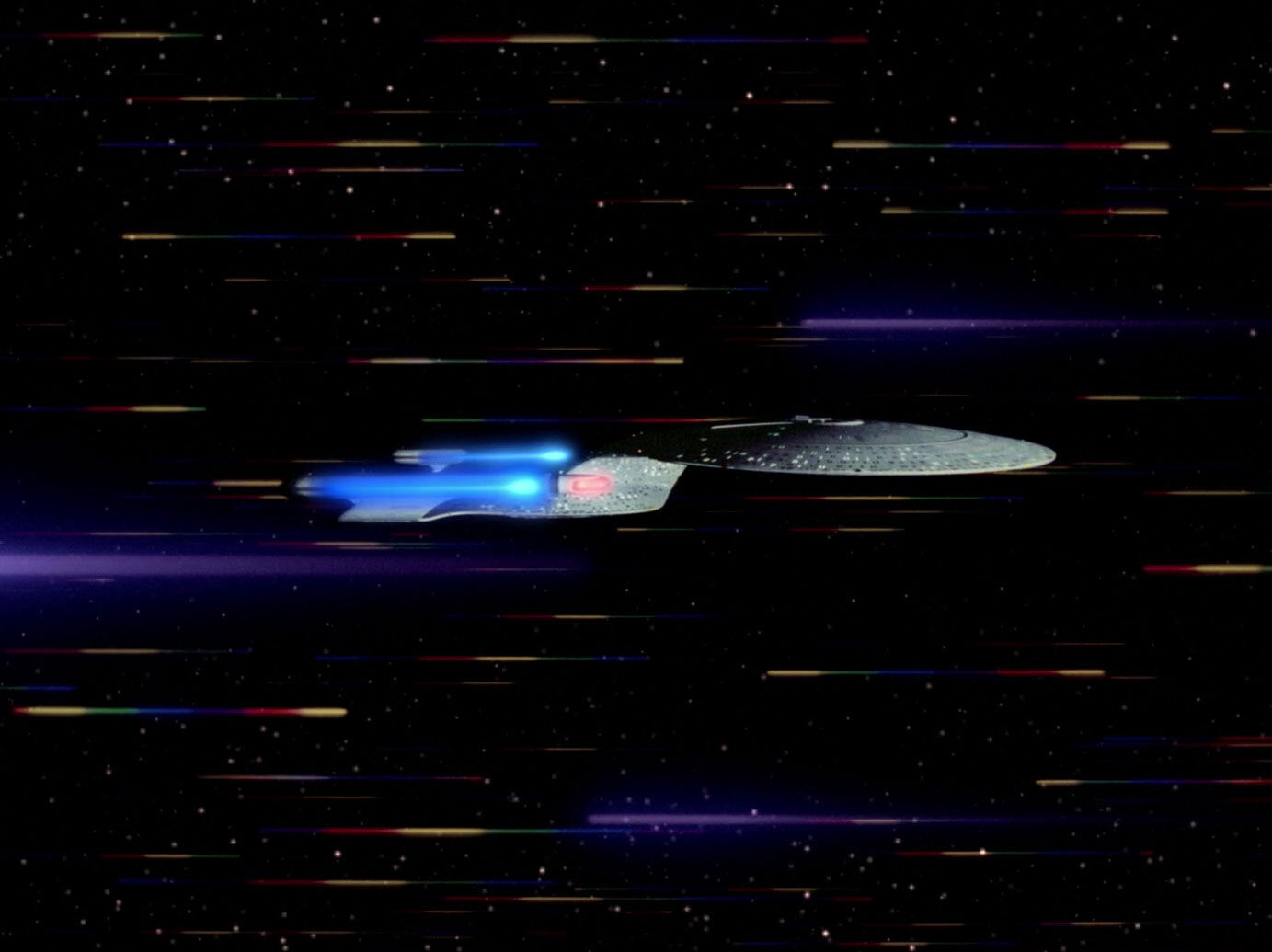
"When the studio asked us to create the distortion effect, we discussed several possible techniques. On the same day, one of our guys up here and Rob Legato at Paramount both began to pursue the same technical approach. We found that while it wouldn't be easy, it would be possible. There are only three shots in the first episode where it needs to make the jump. It looks pretty good. I don't know how feasible it's going to be on a continuing basis to have this jump to light speed; it isn't an easily achieved effect. Of the three shots we did, I suppose one of them could conceivably be used in a stock situation, but so much depends on the script. Usually, when the ships jumps. it's because it is in trouble or something is chasing it or whatever. It remains to be seen how generic the jump we've done for "Farpoint" is." (The Official Star Trek: The Next Generation Magazine issue 2, p. 38)
Legato himself added a simplified sequence, shot on the Paramount Pictures lot itself, "Three warp shots were created at ILM, and one was done here at Paramount. The one we did was a simpler shot of the Enterprise as seen in full profile. When you see the ¾ back shots, the effect needs to be created three-dimensionally; in the profile shot, you get by with doing it two-dimensionally using normal slitscan techniques." (Starlog, issue 132, pp. 55-56) Partly because it was easier and partly because ILM was busy filming the six-foot model, Legato made use of the two-foot model for this warp-sequence as well as for filming some additional stock-footage. (The Official Star Trek: The Next Generation Magazine issue 2, p. 41) Legato's warp sequence was not utilized in the pilot episode, but showed up for the first time in the episode "Where No One Has Gone Before".
These four shots were later supplemented by two more sequences Legato had made for "The Nth Degree" using the same technique. (American Cinematographer, January 1992, p. 87)
Stock footage

Once the "going-to-warp" sequences were completed, attention could be directed to shooting stock footage. ILM took on the task of shooting this footage of the six-foot model. The studio made most of the situation as Carson recalled, "So, whenever possible, we extended the shorts that they needed. For Instance, if they needed a shot of the Enterprise that might be only three or four seconds long for this episode, they would ask us to start the shot much further away and finish the shot much closer, so that we might deliver a 20-second shot, They could use the portion needed for that episode, and hopefully use other parts of the shot or the expanded shot for future episodes as well. (...) Additionally, we provided elements that could be used in more than one situation. In some cases, for example, where they asked for one element with a shadow pass over it, we would also provide an element that had no shadow on it, so they could use it in later shots.", Effects Manager Patricia Blau added. (The Official Star Trek: The Next Generation Magazine issue 2, p. 29)

While ILM was busy composing a library of stock footage of the six-foot model, Robert Legato had other plans with the two-foot model. Feeling that it was impractical to have ILM produce everything on the pilot or eventual follow-ups, he decided to look elsewhere for additional visual effects suppliers. Legato was a former employee of visual effects provider Image G, and approached them with a request to produce effects for the second regular episode, "The Naked Now". Tom Barron recalled its first acquaintance with the franchise: "One day Rob came in the back door with this rock! He literally comes knocking on the door and says, "Hey look, you guys shoot stuff and you got spare time in your schedule. Shoot me this thing." I'm not exactly the most aggressive executive producer around, and we didn't have anything else going on that day, so we shot it." Barron's company shot footage of the two-foot model and the Oberth-class studio model dressed as the SS Tsiolkovsky as a courtesy to Legato. (Star Trek: The Magazine Volume 3, Issue 1, pp. 60-61) Image G eventually became tthe regular provider of motion control photography shots from the second episode onward until the technique was no longer employed in the television franchise.
Discounting the going-to-warp sequences, ILM and Paramount between them produced a library of about forty effects shots of the two models for the pilot. The producers' idea was to use this library for all the ships shots, much like it was done for The Original Series, as a cost saving measure. "The plan was to take the library shots from ILM and add about five per show", Legato said (referring to all VFX shots, not only the ship ones), adding a bit ruefully, "That was probably a little naive... The pilot needed two hundred and ten shots, the second show had seventy-five, the third eighty, and so on, so by the sixth or seventh show we found it was cheaper just to "trick" (custom shoot) each one out." (Star Trek: The Next Generation Companion, 3rd ed., p. 31) More specifically in regard to the Enterprise-D he elaborated, "The ILM method never really panned out. In no time you've run through all the shots and they're all dull, because they don't move. We generally shoot new things for each show. After a while you have so many different variations that you can do it." Having made the comment at the end of TNG Season 4, the library had by then been augmented by Image G to more than 350 shots. (Cinefantastique, Vol 22, issue 2, p. 33)
The remastered edition
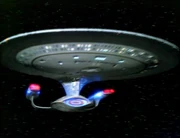 |
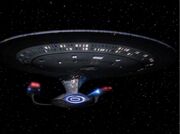 |
In 2012 a start was made with the release of the remastered version of The Next Generation television series, starting with Star Trek: The Next Generation - The Next Level sampler Blu-ray Disc. Like its predecessor, the remastered Original Series, intent of the project was to upgrade the original footage to 1080p high-definition, to meet Blu-ray Disc standards. Unlike its predecessor none of the visual effects were slated for replacement with newly conceived computer generated imagery, or as Project Consultant Mike Okuda has put, it, "We love the approach that CBS took for this project. We take the original film elements and put them together in a new way. The material still has all the details and they are beautiful. And the new visual effects are really the old visual effects but a lot more beautiful than you have ever seen them." [19]
 |
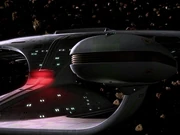 |
The newly composited, enhanced, and color-corrected footage has resulted in far more detailed imagery. For example the hull paneling, including the duck-egg blue highlights, on the Enterprise is better discernible. The project also brought out details that were present in the original film but which did not show up on the original master prints, such as the dim lighting on the ventral side on the footage of the two-foot model. Some use of CGI was made however, but that was restricted to correcting continuity errors, such as the "blinking-off" issue, mentioned above, or for replacing original elements that were either technically impossible to upgrade or simply lost. An example of the latter case occurred for the episode "Booby Trap" where a missing shot of the aft of the six-foot model was replaced with one utilizing a CGI model.
Costs of filming the studio models
The aforementioned Lauritson memos (which were part of of the lots sold on 27 June 2002 in Profiles in History's The Bob Justman Star Trek Auction) also provided some insight into the costs incurred of filming the models for the pilot episode. On 12 May 1987 the motion control photography costs were projected as [20]:
- Miniature Photography (library shots) (includes warp test and video composting)
- US$169,200 ($180,198 including tax)
of which were:
- Build Split-Apart Model Section [remark: The partial "Battle Head" model–see below–for the saucer separation sequence]
- US$15,000 ($15,975 including tax)
- All "Enterprise" and "Hood" Photography (headed as "Motion Control Photography (40 Shots)" on the April 1st memo)
- US$63,000 ($67,095 including tax, adjusted upwards from US$62,200 of the April 1st memo)
Four-foot model
 |
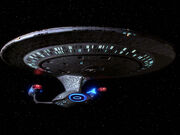 |
During the break in filming between season two and three of the The Next Generation series the Visual Effects Producers made a conscious decision to have an intermediate sized studio model of the Enterprise-D made for practical reasons, what was eventually to become known as the "four-foot" model.
Raison d'être
Overriding practical reasons for doing this occupied the minds of the producers and they were mainly two-fold, as Dan Curry explained:
"We had the six-footer and we also had the two-footer, and something that must have intellectually interesting to Andy was the idea of this perfectly smooth ship that was absolutely huge, and if you saw it in person the scale would be rapidly apparent. But when we photographed the big ship very smooth, we couldn't tell the difference between it and a very small ship very smooth, because photographically, particularly on television and in order to create that sense of scale and hugeness, we needed three-dimensional relief, something to cast shadows. That's why we built the four-footer. And also because the six-footer was really too big to be manageable, particularly when we shot matte passes, where you have enough lit cared behind the ship to obtain a silhouette. (...) So if you had a big move going around it, it would sometimes take a day to get the matte pass because the ship was so huge. And the four-footer turned out to be a more manageable size." (Star Trek: The Next Generation USS Enterprise NCC-1701-D Blueprints,booklet, p. 9)
Echoing Curry's statement, colleague Ron B. Moore has added, "When we started TNG we had two models of the Enterprise-D. One was six feet long and looked really great. We could take the saucer off, though not without a lot of effort. The other was a two-foot model that didn't look so good up close but was great for distant shots. Somewhere around the third season Rob Legato had a third model built. It was four feet and was a great compromise. It gave us a lot more flexibility in shooting the models. From that point on most of our models were at that scale or smaller." (Flying Starships, p. 35) As to underscore the remarks Curry made about the manageability of the six-foot model, a private behind-the-scenes video shot by Gary Hutzel demonstrated that it took six people to move that model around. "It takes six guys just to take it of the stand and turn it over, and those guys are wetting themselves with fear, because you drop this or a nacelle breaks or something, you could set the company back.", Doug Drexler jokingly commented. [21](X) On a more serious note, Rob Legato additionally commented, "I didn't agree with the idea of making the model that big originally. It made shooting difficult because you couldn't get back far enough. [remark: Legato refers to the space limitations at Image G where the camera, due of the size of the model could not be retracted enough to get forced perspective shots] And there was no detail on it, Detail was drawn on in pencil. You can't get close to it, so there's no reason to have it that large." (Cinefantastique, Vol 22, issue 2, pp. 33-34) Legato went on explaining that the lighting system on the six-foot model was very cumbersome, needing a full hour just to set up the model for filming. Hutzel devised an on-board neon transformer for the new four-foot model, allowing the lighting scheme to be changed by flipping a few switches and avoiding being electro-shocked, as he was by the big model.
The four-foot model was also useful for close-ups as well as for forced perspective shots, thereby eliminating the need to switch between the two-, and six-foot models at Image G resulting in significant time savings. This versatility of the four-foot model rendered the original models virtually obsolete as they were almost never utilized again.
Build
Once the decision was made, the task of building the model fell upon Gregory Jein, Inc., whose four-man team, which included, amongst others, Bruce MacRae [22] and Dana White, had to pull off all-nighters during the 1989 Thanksgiving season to have the model built in time. His team also received help from production staff associates David Takemura and Michael Okuda [23](X) and outside contractors Ed Miarecki and David Merriman, Jr.. Merriman recalled:
"Greg called, explaining the need for a smaller miniature, and asked if we had time to build a master of the warp engine and wing section of the secondary hull. Later in L.A., our masters would be used to make molds and from those tools, the translucent GRP parts [remark: the transparent grills on either side of the nacelle] of the actual miniature. (...) The completed four foot long 1701-D was, of course, an amalgamation of work performed by several people. Ellie [remark: Meriman's wife] and I did the warp engine and wing structure masters. I understand that Edward [sic] Miarecki, the same guy who did the recent, and by far the best restoration of the TV 1701 miniature, worked up the secondary hull master. Greg Jein farmed out the glass work to an outfit in Burbank and his crew did the primary hull, part assembly, painting, and weathering." (Sci-Fi & Fantasy Models, issue 30, 1998, pp. 36, 38)
Jein later related:
"When the series got a Go, they decided that at that point they needed a smaller model so they could get their camera back farther and make it disappear into infinity faster. It was also decided at that point that they would have more detail on the ship and the model that we handled down here was about four feet long and it had a lot more surface detail, so the lights would create more details on the surface. I have here a pattern for the nacelle and if you play it through the light you can see the detail that is inscribed into it. (...) This is a big difference from the ILM size." (TNG Season 3 DVD-special feature, "Departmental Briefing, Year Three: Production")
While proud of his and his team's creation, Jein recalled the sense of relief they felt upon the model's completion. "I remember when we finished work on the 4-foot miniature version of the U.S.S. Enterprise (there are several version of the starship, from 6-foot long down to only a few centimeters), we filled a thin glass grape mold with sparkling soda and "christened" the ship/model." (Star Trek: The Next Generation - Behind the Scenes, backside card 26)
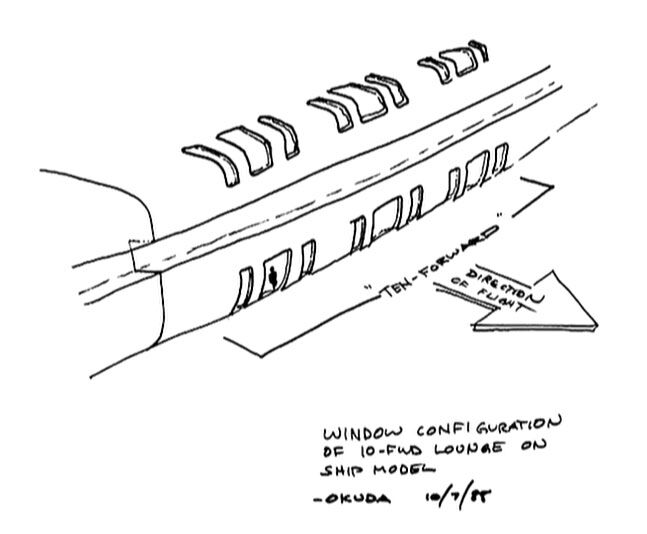

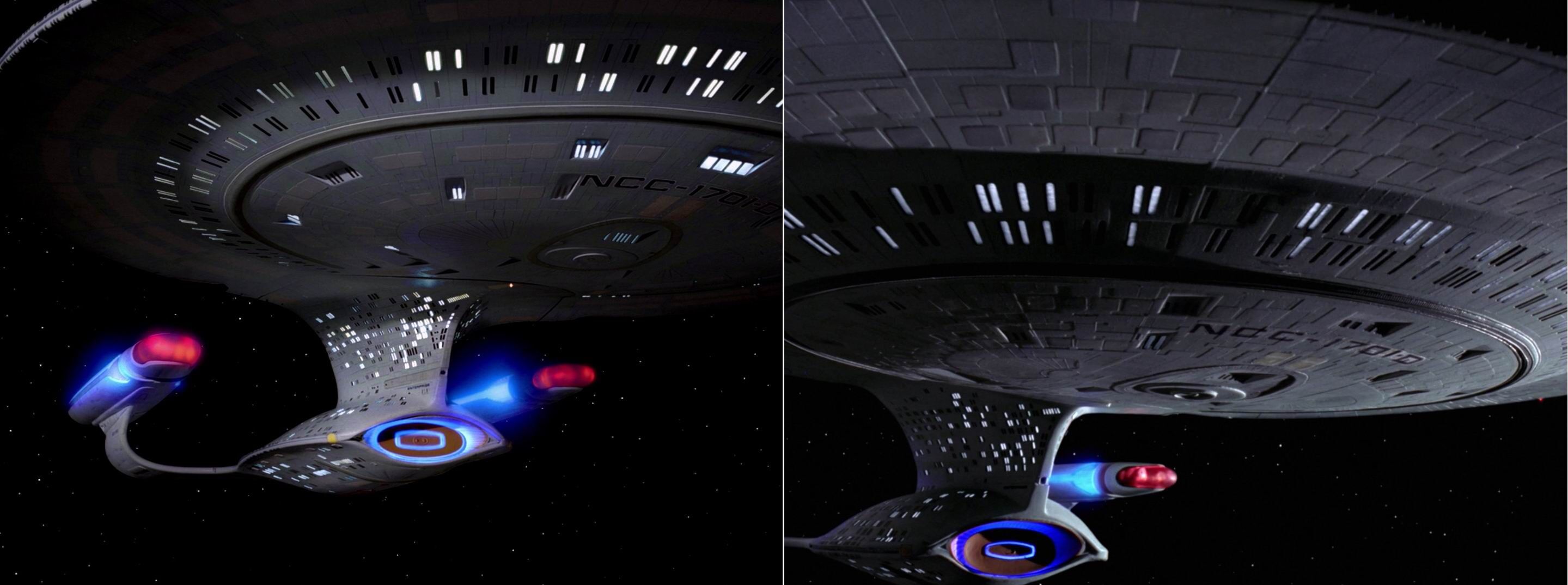
Though intended to represent the same vessel, there were some other differences between the six and four-foot models as well. In order to address Curry's concerns, the surface details were slightly raised whereas the surface on the big model was smooth. "They wanted a more realistic look than the smooth surface of the initial Enterprise. We devised a thin layer of what we call 'plating'-raised surfaces. With rim light you can eventually see it's not a flat surface. There are actually levels of detail.", Jein elaborated. (Cinefantastique, Vol 23 issue 2/3, p. 95) Additionally the layout and size of some of the windows on the leading edge of the saucer section were slightly altered, to reflect the location of Ten Forward, introduced during the run of the second season, as envisioned by Mike Okuda in October 1988. Also the saucer rim was somewhat thicker, which also applied to the shape of the secondary hull that was most discernible in the deflector dish assembly area as well as the dish itself. These alterations were designed to address the issue of the Ten Forward set not having been built to scale down correctly to the window detailing of the forward rim of the six-foot model (citation needed • edit), and it resulted in a model that had a slightly "stockier" appearance. Finally the base hull color was shifted to a lighter blue- almost white-gray tone, though that had negligible effects under shooting conditions. A final, small difference, only discernible in close-ups, was the deflector dish. Aside from the overall shape, the large model had a central detail feature on which were sported two horizontally aligned circular features. These were lacking on the four-foot model, as they were on the two-foot model. Like the small two-foot model, this model also was built without the capability of saucer separation.
The slightly altered look received some mixed reactions as evidenced by a remark Dan Curry made:
"I love the shape of the Enterprise. It's fluid, it's elegant, it's got a sleekness to it. The fact that the saucer is not a circle but an ellipse reminds me of Trojan shields. It presented an engineering challenge, for sure, with all the stresses that the armature inside has to take, but I also think it presented a real opportunity. With the six-footer, most of us like the sculptural proportions a little bit better than on the four-footer. The four-footer is a bit more of a bulldog; it's stockier, whereas the six-footer really has a sleek elegance about it." (Star Trek: The Next Generation USS Enterprise NCC-1701-D Blueprints, booklet, pp. 9-10)
Use
 |
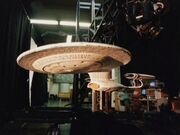 |
Debuting in "The Defector" (Star Trek: The Next Generation Companion, 3rd ed., p. 99), it was this model that was almost exclusively used for any newly shot footage for the remainder of the series. The model was never relabeled nor modified for The Next Generation series to represent other vessels until the finale "All Good Things..." were it was extensively modified to represent the anti-time future variant.
Intensive use was made of the four-foot model at Image G for the episode "Parallels" where the appearance of thousands of Enterprises was called for. Effects Supervisor for the episode Ronald B. Moore recalled:
"The writer Brannon Braga contacted me and asked if it would be possible to show hundreds and thousands of Enterprises in the same shot. He was worried because he knew that if it cost too much the effect could end up being scaled down, which often happens. A script might start out asking for a fleet of hundreds of ships but then it becomes dozens and finally we're viewing this incredible fleet from the rear so the three leading ships are all we see. Brannon thought the effect was important so he wanted us to be prepared. It sounded interesting so I told him that we could do it within our budget. Then I had to figure out a way to do it!"

Options Moore considered were using a matte painting ("I decided against that because I didn't think it would have the right texture, and I wanted to have real lights on all the ships. I think the lights of the Enterprise are one of the most striking things about the ship and I didn't want to lose that."), hanging multiple models of the ship on wires (he decided against that as the slightest disturbance would cause the models to bounce around like "Christmas tree ornaments") and using existing stock footage which would not do because, "(...)the lighting on the ships would have been different for every one, and I needed them to look consistent." (Cinefantastique, Vol.25, No.6/Vol.26, issue 1, pp. 54-55)
CGI not yet being an alternative at the time, Moore eventually bowed to the inevitable:
"I finally bit the bullet and shot hundreds of Enterprises at Image G. I'd do one version, rotate the Enterprise slightly and then do the next one and the one after that until I'd photographed it from every angle I could. Then I turned the model upside down and repeated it. It took a long time to get all the elements I needed because each ship had to be filmed with multiple passes, but I felt it was worthwhile because every ship in the shot is the actual Enterprise, which is the whole point of the shot. Then I added them to the frame, starting with those that were furthest from the camera. These were so small I pretty much rubber stamped from the different versions I created. As I worked forward I added more variety in terms of movement and orientation, until the screen was filled with Enterprises."
Despite the enormous amount of work the shot was delivered on time and on budget and received high praise from the producers, though Moore had an even more ambitious shot in mind, "Ideally I'd have loved to have done a sweeping camera move through all the Enterprises, but we didn't have the time or the money for it. It's something you learn to accept when you work in television, because there are always those extra touches you wish you were able to do." (Cinefantastique, Vol.25, issue 6/Vol.26, issue 1, p. 55)
"All Good Things..."
For its future variant appearance in "All Good Things.." the four-foot model was endowed with various add-ons, designed in a collaborative effort by Dan Curry and Greg Jein. Musing about how the Enterprise would look like twenty-five years in the future, Curry elaborated, "I took a model of the Enterprise, some clay and a few spare parts and began experimenting. Everyone had ideas and Greg Jein suggested adding the third engine that helps give the future Enterprise an unique look. I sculpted a rough warp engine and added it to the model. I was very crude, like something a child would do, but we showed that to executive producer Rick Berman who thought we were headed in the right direction. Once we had Rick's approval, Greg went to work on it." (Cinefantastique, Vol 25 issue 6/Vol 26 issue 1, p. 67) Using the molds he had of the studio model, Greg cast a third warp nacelle assembly which also included two additional impulse engines. The 21" × 10" × 4.5" part, constructed around a metal armature and rigged throughout the inside with electronics and halogen bulbs for internal lighting, was attached to the spine of the secondary hull. Other parts that Jein's shop manufactured to complete the transfiguration into a future variant were the phaser canon assembly on the ventral side of the saucer, the twin torpedo launcher and two antenna like features aft and on either side of the bridge module respectively, phaser strip assemblies on top of either port and starboard warp nacelle and "speed" fins on both nacelle struts.
Doug Drexler recalled an in-joke having been performed on the model by Jein's staff when he visited the completed model on stage, "I remember going down to "G" with Mike and Denise to see the Future D on the stick. I recall that the ship had a tiny bumper sticker on its tail that said "I Heart Uranus" [24]," – though a picture from Eric Alba later showed up where it could be discerned that the sticker actually read, "We Heart Uranus". [25]
The thirteen modification parts, constructed out of fiberglass re-enforced resin, were removable and as one-time only pieces normally slated for discarding. However, Visual Effects Supervisor Gary Hutzel, who genuinely loved the traditional methods of visual effects production, could not bring himself to let these parts go, and saved them from the dumpster, keeping them in storage for two decades. [26] Ultimately though, Hutzel offered these pieces up as Lot 1 at auction in Propworx' Star Trek Auction V of 30 May 2015, where they sold for US$9,500 ($11,210 with buyer's premium), having had an estimate of $3,000–$5,000. [27]
Final production uses

Following completion of "All Good Things..." the model was relabeled for the first time as the USS Odyssey (NCC-71832) in the Star Trek: Deep Space Nine second season episode "The Jem'Hadar". The relabeling was done by Doug Drexler at the Art Department, who elaborated, "Occasionally if a miniature needed graphic retouching, VFX would arrange to have the teamsters pick the model up [note: from Image G] and bring it to the art department. That was always a big event, because the ships were our idea of celebrities. They, more than anything, seemed to embody what the show was all about... symbolic of Human aspiration and ingenuity." [28](X)
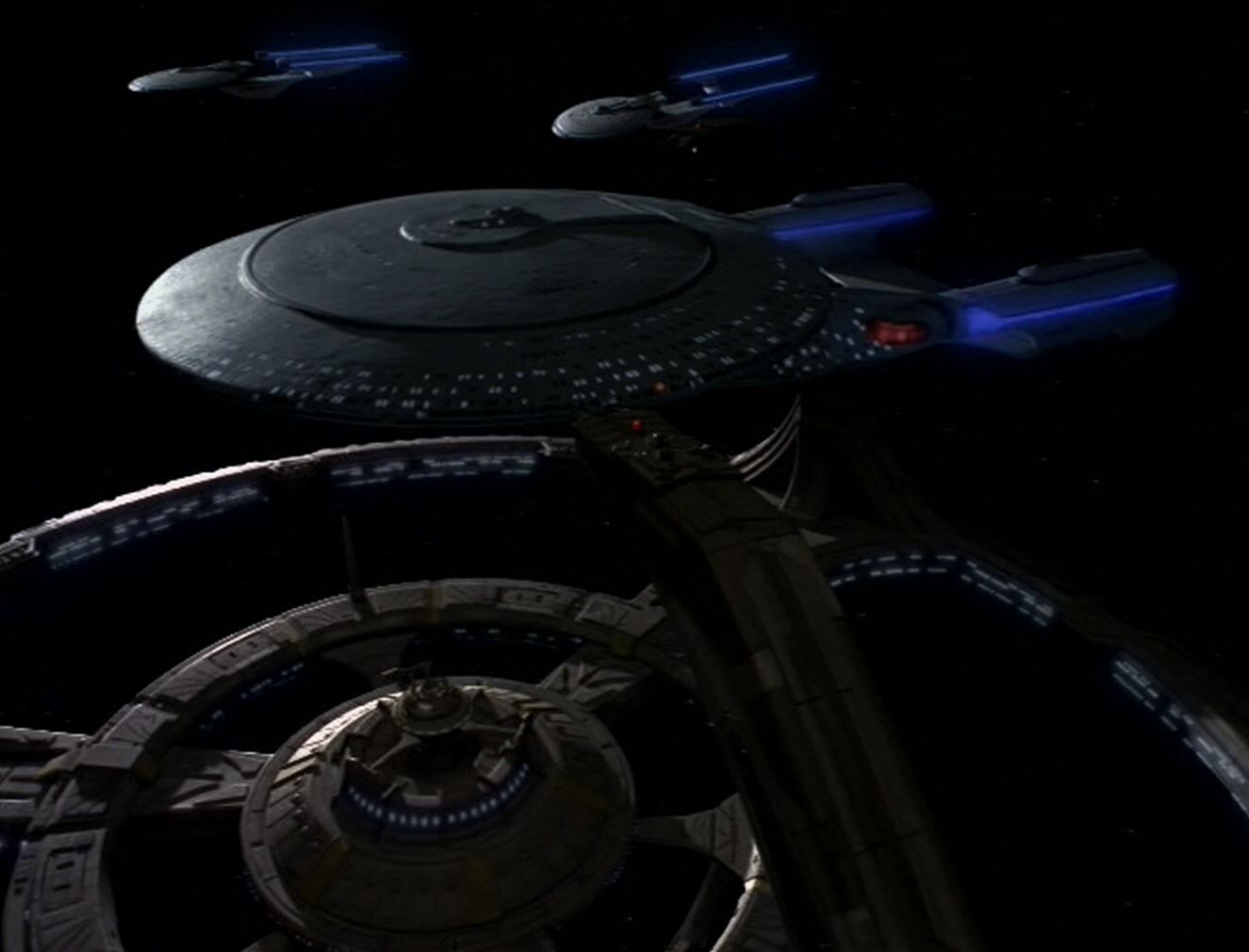
Believing that the model had reached its end as an useful production asset, the studio released the model (labeled back to USS Enterprise NCC-1701-D) for public relations purposes, appearing for the first time as a display piece in the February 1995 opening leg of the Star Trek: The Exhibition tour in Edinburgh, UK. (Sci-Fi & Fantasy Models, issue 6, p. 24) Still, Visual Effects Supervisors Glenn Neufeld and Gary Hutzel had one more use for the model in mind for the fourth season episode "The Way of the Warrior" and the model (along with the Negh'Var studio model) was hurriedly pulled from the tour in May 1995. Labeled USS Venture (NCC-71854), the model was featured at the end of the episode as part of a relief force, interestingly sporting the phaser assemblies on the nacelles as featured in "All Good Things...", albeit in a reversed orientation and applied to the model by Hutzel, who had earlier taken the parts under his wing.
Its performance in the episode proved to be the very last time the four-foot model – or any of the physical studio models – was used as a production asset. The next new-footage appearance of a Galaxy class vessel in "Call to Arms" was already being executed as a CGI effect. [29]
Post-production "odyssey" of the four-foot model

The four-foot model came very close to sharing the fate of its illustrious predecessor, the three-foot Constitution class studio model. Eager to get in on the hype surrounding the Planet Hollywood restaurant franchise craze around 1995, the studio immediately loaned out the model in its USS Venture livery to the newly opened Beverly Hills branch for display purposes – where it was photographed as such in October 1995 by William S. McCullars for his now defunct "The IDIC Page" website [30](X) – , and subsequently…lost track of it. Penny Juday related in the TNG Season 2 DVD-special feature, "Inside Starfleet Archives", "One of the things we were searching for to keep in the archive was the model of the Enterprise-D that was used throughout the entire series [sic; Juday was also in error in her assessment that the model was made by ILM]. We could not find it anywhere and we had no real idea where it had gone." The model was eventually returned to the studio by a conscientious ex-employee when the Beverly Hills restaurant defaulted in 2000. "And I get a call from Gil Johnson from the back lot, and he says, "Downstairs in the construction office, we have this model laying on the couch that someone, it just appeared and we don't know really where it came from. Somebody brought it in, set it on the couch and here we are. We don't know really what it is, can you come over and take a look at it." So, I go over and looked at it, and knew pretty much right away what it was. So a little bit teary, I said "I need to get hold of someone who knows for a fact and can confirm my thoughts on this". So I called Mike Okuda, he came down and stood there looking at it, jaw dropping, and said "Oh my God". It was the model of the Enterprise-D for Star Trek: The Next Generation that we thought had disappeared, we thought surely somebody had absconded with.", Juday continued.
The archival photos Juday took showed the model still bearing the USS Venture markings, though only the registry – NCC-71854 – was legible. She went on describing the dire straits the model was in: "Apparently, it had been loaned for display in one of the restaurants. It had been hanging over a grill for quite some time apparently. It still had the wires hanging from it that they used to suspend it with, and holes that they had drilled in it. The nacelles were broken, it was in a really, really bad condition, as you can imagine, and it was also covered in a few layers of grease besides. And so now it's back in our possession, safe and sound in a little crate, stored in a very secret place! So, hopefully, somewhere in the near future, we get to restore it.". It lent credence to some earlier witnesses' reports on internet blogs that the model had been sighted suspended in a kitchen over an open stove. [31]
Unlike its larger counterpart, the four-foot model was retained by the studio. It has since been restored to its Enterprise-D designation and included as display piece in the Star Trek: The Exhibition tour as late as 2012. [32]
Four-foot break-away models
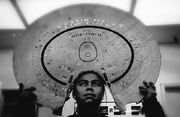 |
 |
 | |
On one occasion, special purpose models, cast from the molds of the four-foot model, were constructed as break-away models for use in the Next Generation season five episode "Cause And Effect". It was felt that the special occasion of the Enterprise-D's destruction warranted a more realistic and impressive explosion. Normally, at that time, the technique used was superimposing an image of an explosion over stock footage of a physical studio model of the ship in post-production, but in this case an actual model was filled with explosives, and blown up while shooting it from multiple angles. Visual Effects Associate Eric Alba recalled, "They blew up four or five models, all built by Greg Jein. Greg always kept the molds – what we called the negative – for the ships he built, so he could create new pieces if he had to repair something. Greg had to paint them and put all the details on, but he didn't have to include lights. (...) The models were pre-scored so they would break apart easily during pyro." (Star Trek: The Next Generation 365, p. 500) Typically, the debris of these models was discarded after use, but in this case the debris was gathered up on a hunch by Effects Supervisor Gary Hutzel who recalled, "Last season we blew up a model for the Enterprise, by dropping it from the ceiling of the sound stage toward a high speed camera while timed charges went off to blow it up in mid-air. I went around with a cardboard box and picked up all the pieces of the model I could find, because I knew they would come in handy someday." (Cinefantastique, Vol.25 issue 6/Vol 26 issue 1, p. 109)

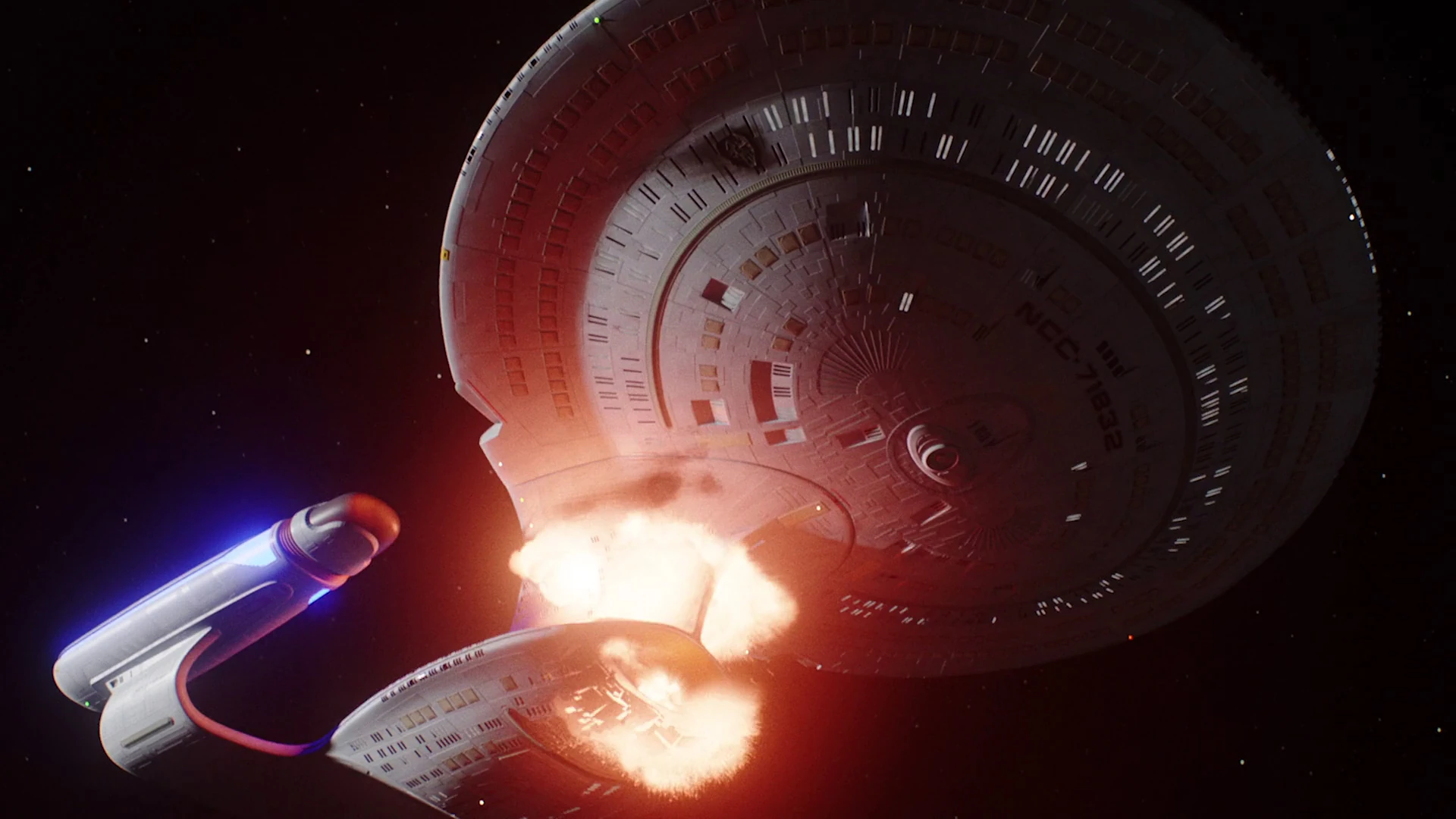
The debris was indeed re-utilized for the destruction of another Galaxy-class vessel, the USS Odyssey in "The Jem'Hadar". Hutzel continued, "My coordinator David Takemura combined these with pieces from kits to create a broken neck and dish for the Enterprise. We also had a nacelle we were going to use, but it was stolen." The nacelle Hutzel referred to was replaced by the battle damaged Miranda-class nacelle, while the Constitution II-class battle-damaged primary hull model was used for the saucer section. Takemura elaborated a bit further, "Someone had the presence of mind to save the pieces and store them. I took a piece of the bottom of the cigar section of the Enterprise, did some kit bashing, and made a demolished version of the bottom of the ship." (Star Trek: Deep Space Nine Companion, p. 155) In post-production editing, in order to create the finalized scene, Pat Clancey at Digital Magic was responsible for aligning all the debris footage with those of the Enterprise studio model, shot at Image G, while Animator Adam Howard combined these with stock footage of explosions and footage of the Jem'Hadar fighter in post-production editing.
As it turned out, one of the break-away models escaped being used and was afterwards retained by Ron B. Moore as part of his personal collection. [33] Additional surviving copies were kept at Image G, as uncovered by Doug Drexler and Gary Hutzel. [34]
More break-away models subsequently turned up at auctions. An unused one, renamed to "USS Neufeld" as an in-joke, was reassembled and put up for auction at Prop Store Ltd. in 2017, though the it would go unsold. [35] The remains of a screen-used break-away model were auctioned off, again by Prop Store Ltd., in 2023. [36] The winning bidder being Mike Stoklasa of the Red Letter Media Youtube channel. [37]
Four-foot derivative ship class studio models
For the fourth season of The Next Generation, Gregory Jein, Inc. made use of their own production assets in the form of the molds they had of the four-foot Galaxy-class model, to cast parts in order to create various other Federation ship classes. Parts were cast to construct the Freedom-class and the Niagara-class for the "graveyard" scene in the season's opening episode "The Best of Both Worlds, Part II" episode, and in particular the Nebula-class studio model for the later fourth season episode "The Wounded".
Freedom-class studio model
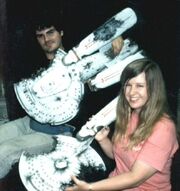 |
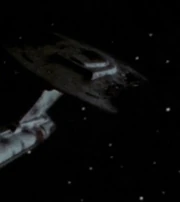 |
Jein and his staff created the scratch-built "kitbash" studio model of the Freedom-class USS Firebrand for the "graveyard" scene that the Enterprise-D traveled through following the Battle of Wolf 359, from the start as being pre-damaged . Jein used the molds he had of the Constellation-class and the four-foot model to cast parts for the neck and nacelle, respectively. The other parts he built from scratch. Michael Okuda recalled, "Freedom: Upon reflection, I think this may have been something that Greg Jein came up with for one of the kitbashes he contributed to either BOBW or Unification. I'm not sure which model this was, and I'm not at all confident that Fact Files checked with anyone." [38]
- Additional link: Freedom class reconstruction at Ex Astris Scientia
Nebula-class studio model
- See: main article
Niagara-class studio model
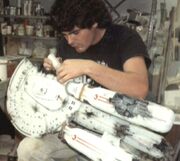 |
 |
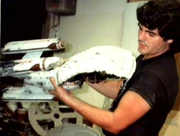 | |
Like the Freedom-class, the equally scratch-built studio model of the pre-damaged Niagara-class USS Princeton was created at Gregory Jein, Inc. for the "graveyard" scene that the Enterprise traveled through. Jein used the molds he had of the Ambassador-class and, again, the four-foot Galaxy-class studio model to cast parts for the secondary hull and nacelles, respectively, or as he has stated, "But we did a three engined ship for that and we did a one engined ship for that, which I think I still have someplace, because I just let them use that out of our stock inventory. We just took parts of the Enterprise we had left over and added nacelles and some other crap to it like that." (The Best of Both Worlds (Blu-ray)-special feature, "Regeneration: Engaging the Borg"). The other parts he built from scratch. This model too, was from the start constructed as being pre-damaged. Okuda later remarked, "Greg Jein built a number of severely-damaged hulls and parts for the graveyard scene. Greg is one of the unsung heroes of Star Trek. (...) The three-nacelled ship was made by Greg Jein. (...) I remember reminding Greg that Gene didn't approve of odd-numbers of nacelles." [39] The Surplus Depot Z15 appearance of the class in "Unification I" was stock footage of "The Best of Both Worlds, Part II".
Jein used his own production assets for all his derivative ship class builds, unlike Okuda, Rick Sternbach, and Ed Miarecki, who constructed their models from commercially available AMT/Ertl model kits, enhanced with miscellaneous other pieces and first built "intact" and "damaged" later.
- Additional link: Niagara-class reconstruction at Ex Astris Scientia
Four-foot commercial models

A limited edition of twelve, built from the same molds as the four-foot studio model, was later sold in 1997 at the Viacom Entertainment Store in Chicago. They came with certificates of authenticity, signed by Jein, but were more crudely detailed and sported no internal lighting. [40](X)
In the same period sightings were reported on the internet of four-foot models being displayed in several Planet Hollywood restaurants. With the exception of the one in the Beverly Hills restaurant, these were either especially commissioned models Greg Jein, Inc. had built for the restaurant franchise using the molds of the four-foot studio model [41] [42](X) or models originating from the 1997 commercial production run, or both.
One of these showed up as Lot 307(X) in the The Ultimate Sci-Fi Auction of 26 April 2003, in the catalog misrepresented as "(...) this 4 ft model was used as the main filming miniature." (Profiles in History presents: The Ultimate Sci-Fi Auction catalog, p.84) Estimated at US$20,000-$30,000, it reportedly sold for US$20,000. Though outfitted with internal lighting, the model was in fact identified as a display model for a Planet Hollywood restaurant in the Far East, the lighting more than likely applied by Planet Hollywood's own prop house in Orlando, Florida. [43](X)
In the same vein, there is an alleged sighting of a four-foot physical model at a Planet Hollywood restaurant labeled USS Trinculo (NCC-71867), though it has never been clear in what respect that labeling was done nor have any photos of the model surfaced. Still, the report of this name and registry has proven to be so persistent that it has made his way into the officially-licensed reference book USS Enterprise Owners' Workshop Manual of 2010 (p. 102).
None of the commercial four-foot models were ever used as production assets.
Partial physical models
While the six-foot and two-foot models, and later the four-foot model as well, were sufficient to provide all of the necessary wide shots for the new television series which depicted an overview of the ship, there were instances (even in the pilot episode) when more-detailed "specialty" models were required to depict close-ups of certain exterior parts of the ship. Models were also occasionally produced to depict (in miniature) internal areas of the ship.
The "Battle Head" model
 |
 |
 |
For the saucer separation scene a close-up was required that could not be done with either model. Instead a special larger scaled model, constructed out of resin, glass fiber and aluminum highlights, was built of the top of the Enterprise-D's neck with operating latches, known as "Battle Head", "Copper Head", or "Cobra Head". Also designed by Andrew Probert, the final exterior view concept was turned in on 1 April 1987. At ILM the model was filmed in action for "Encounter at Farpoint", footage of which appeared in later episodes of the The Next Generation series as well as in Star Trek Generations.
As noted in the aforementioned Lauritson memos, this particular specialty model was a surprisingly expensive build in relation to the two full filming models, coming in at US$15,000 ($15,975 including tax) as opposed to the US$75,000 the construction of the two filming models cost.
That model, including some of the latches, was eventually offered up as Lot 709(X), measuring 21×25 inches, in the 40 Years of Star Trek: The Collection auction with an estimated sale price of US$1,500-$2,500, selling for US$3,000 ($3,600 with premium) on 7 October 2006 to American collector Eric Gunzinger.
Sensor strip detail model

One of the more unusual partial models, was the sensor array strip detail model that was featured in the The Next Generation's second season episode "The Child". The model was used for an establishing shot where the camera sweeps over the saucer rim at close range, past the strip and focused in on the outside windows of Ten Forward. The model was constructed by Michael Okuda, who had commented, "I made the sensor strip model for Rob Legato and Gary Hutzel. It was a cool idea, but I don't think it was successful in conveying the location of Ten Forward on the saucer rim." [44]
Dorsal saucer section and core section models
In the subsequent season two episode "Q Who" the Enterprise-D was caught in a Borg tractor beam, with a separate cutting beam slicing out a section of the primary hull. Conceived in the pre-CGI age the scene was entirely executed with especially made models. Dan Curry explained:
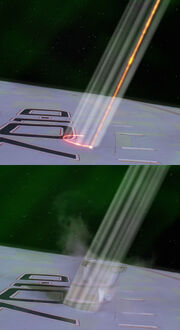 |
 |
 |
 |
"Shot up that close, the inadequacies of a model that size would have been too obvious. You would have seen the grain of the paint! Also, to enable the thing to come out we would have had to cut a hole in the Enterprise specifically for this shot. We didn't want to do that! We made a very large model of a segment of the saucer section. It looked even bigger than it was because it was built in forced perspective, but that meant it only really worked from one angle. Then we made a little model of the actual slice; that was maybe two feet long by 12 inches [sic] or so in diameter. The saucer section was maybe 15 feet on its side."
Kim Bailey of Starlight Effects was contracted to build the models. Due to the large visual effects demands needed for the episode, Bailey, hired model maker Gene Rizzardi for the construction of the forced perspective saucer model.
The cross-section model, referred to by Bailey as the "Enterprise Core Sample", and built by him and David Heilman, was constructed in such a way that it slid neatly into a specially prepared hole in the larger model. "There was a hole in the large model of the saucer section with a tube in it. That acted as guide that we could shove the section out of mechanically.", Curry continued, going on explaining that the telltale lines on the saucer where the two models met, were disguised in post-production both by digital erasing and by superimposing the tractor, and cutting beams over the area. (Star Trek: The Magazine Volume 3, Issue 2, pp. 45-47) Bailey and Heilman needed three weeks to complete the model. This was its only appearance on the series.
The model, measuring six inches in width and constructed out of styrene plastic and other materials, was featured in the TNG Season 2 DVD-special feature, "Inside the Star Trek Archives". It showed up at the 40 Years of Star Trek: The Collection auction as Lot 691(X), estimated at US$1,000-$1,500, where it sold on 7 October 2006 for US$5,800 ($6,960 with premium) to American collector Adam Schneider. [45] It was also included as part of the MoPop Star Trek: Exploring New Worlds exhibition.
The large saucer section model was more than likely discarded, as was commonplace with episode-specific production pieces this large.
Nacelle models
 |
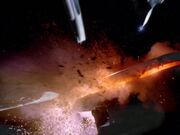 |
 | |
 |
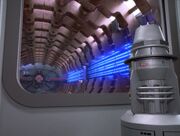 |
At least on one occasion a nacelle was cast from the molds of the six-foot model at Gregory Jein, Inc. to appear as debris in the season four episode "The Best of Both Worlds, Part II" in the "graveyard" scene. On another occasion, a close-up was deemed necessary for the season five episode "Cause and Effect", when the Enterprise-D is hit by the USS Bozeman, so for that purpose a large starboard nacelle with strut, measuring 82 × 35 × 21 inches, was constructed out of fiberglass and resin. The model was for the scene packed with pyrotechnics and subsequently detonated, causing the outer grill to be blown off.
The large nacelle model was sold as Lot 707(X) in the 40 Years of Star Trek: The Collection auction with an estimated sale price of US$3,000-$5,000, selling for US$4,000 ($4,800 with premium) on 7 October 2006 to American collector Adam Schneider. [46]
For the season seven episode "Eye of the Beholder", a specialty maquette of an interior of the Galaxy-class warp nacelle was called for as per specifications of the script, showcasing for the first time the warp coils touched upon in the Star Trek: The Next Generation Technical Manual. Originally it was intended to have the shot of the interior executed as a CGI effect, for which Rick Sternbach produced preliminary CGI designs. However as Doug Drexler recalled, "The original plan was that Rick wanted to attempt to build the coils in CG, but it didn't quite work out. If memory serves, the render time per frame was enormous, and it became impractical. It was a nice try, but it would be a few years before off the shelf CG programs were up to snuff, and we ended up building it physically instead." [47](X) Continuing he has added, "I made a couple of sketches for Mike Okuda to approve, traced out the profile of a warp coil, ran down to the mill, and had the boys cut a wooden template. I handed that off to Anthony Fredrickson who used a vacuum form machine left over from the makeup days to pull a bunch of warp coils. He then painted and assembled it. That was fun!" [48](X) From the wooden template Fredrickson manufactured vacuum-formed styrene copies and had them assembled into the final model. He included foam coffee cups for dividers as well as blue-gelled plastic with black tape to set off the glowing nacelle "grills". Measuring approximately 2.5 feet across, the seven coils as built by Fredrickson had to be optically doubled to fourteen in post-production at Digital Magic, where Effects Supervisor David Stipes had also lengthwise runway lights and a ceiling piece optically added. (Star Trek: The Next Generation Companion, 3rd ed., p. 287; Star Trek: The Next Generation 365, p. 342) The maquette has not been seen since.
The turbolift shaft model

The episode "Disaster" featured a scene in which Captain Picard and a young boy escaped from a stuck turbolift by climbing up a turboshaft. The shaft was neither a matte painting nor a set, but rather a small maquette built by WonderWorks Inc., as Dan Curry has explained:
"There was a shot in which Captain Picard looks down the shaft and we see the boy he's looking at. We shot the boy against green screen because he was wearing a blue costume. But the model of the turbolift shaft [built by Brick Price] was only eight inches in diameter. We had to be carefully plot the perspective so when we combined the boy with the miniature, the lighting matched and the perspective was proper." (Cinefantastique, Vol 23 #2/3, 1992, p. 41)
Footage of the maquette, taken for this occasion, turned up several years later as a USS Voyager turboshaft in Star Trek: Voyager's season four episode "Year of Hell". This maquette too, has never been sighted again afterwards.
Main shuttlebay maquette
 | |
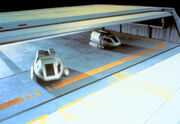 |
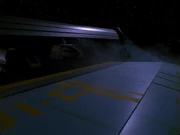 |
For "Cause And Effect", a close-up was also required of the otherwise never utilized main shuttlebay. The build was incorrectly attributed to Mike Okuda in Star Trek: The Next Generation Companion, 3rd ed., p. 195. It was actually Ed Miarecki's company, Science Fiction Modelmaking Associates (SFMA), which was contracted to construct the bay maquette. Stated Miarecki, "This set miniature, built in five days, featured a hangar door, which worked like a roll-top desk, and was powered by a cordless electric drill. The two Shuttlecraft in the scene were named for the shows producers, "Berman" and "Pillar" [sic]." [49](X) Miarecki created three more tiny Type 6 shuttlecraft and one more Type 15 shuttlepod to go with his maquette. [50](X)
Neither the maquette, built around a wooden frame, nor the bay itself were ever called upon to make another appearance again.
The model, measuring 9 × 48 × 57 inches was eventually listed as Lot 6779 Lot 6779 (X) in the It's A Wrap! sale and auction where it sold for US$3,050 on 17 February 2008, again to American collector Adam Schneider. [51]
The large primary hull and partial saucer rim models
 |
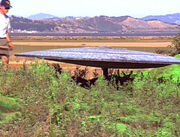 |
 |
 |
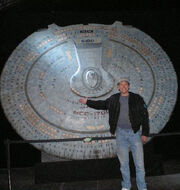 |
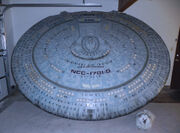 |
For the saucer crash scene in Generations it was quickly decided to have a larger model build of the saucer section, both as not to have the six-foot studio model damaged as well as for practical cinematographic reasons. John Knoll initially wanted to construct a twenty four-foot model, but had to settle for a smaller twelve-foot variant for budgetary as well as practical reasons. "Going with a smaller model made it easier to rig and less expensive, but it also caused depth of field problems and forced us to shoot at a higher frame rate than we would have liked.", he explained. (Cinefex, issue 61, p. 74) Measuring 12'1" long × 9'10" tall × 11" wide, the model was and constructed out of wood with a fiberglass and resin outer shell and contained a functional internal lighting system. It was rigged on a truck-powered dolly rig that dragged the model over an eighty-foot long by forty-foot wide maquette of the Veridian III landscape, also especially constructed for the scene by ILM. "The saucer was mounted on an extendible post that that ran down beneath the set. We had two guys underneath controlling the saucer's motion from this cart, which had pulleys attached and was connected to a rental pick-up.", Knoll continued. As was related in the Star Trek Generations (Special Edition) DVD special feature, "Crashing The Enterprise", several takes were shot on the ILM back lot in direct sunlight using several high-speed cameras filming the action from different angles. For this reason, the ventral side of the model was not detailed and no shots of the ventral side were seen in the movie. Prior to the construction of the landscape and saucer models, ILM modeler John Goodson constructed a small concept maquette for the producers to mull over. (Star Trek: The Next Generation Sketchbook: The Movies, p. 26)
For the extreme close-ups where the saucer was seen careening over the jungle floor up close, an enlarged wooden leading edge of the saucer, representing the Ten Forward area was constructed. ILM modeler Howie Weed explained, "On the other dish, about 6 inches across would equal this whole 12-foot model. Even though we can build really highly detailed models very small, water droplets still look like water droplets, dirt still looks like dirt. So, we build a model real big, we can get real close to it, and when it interacts within an environment it looks more realistic. We can see clods of dirt flying over it, bigger trees, leaves flying off the trees, things like that." (Star Trek Generations (Special Edition) DVD-special feature, "Inside ILM: Models And Miniatures")
The shot in the movie of the crew standing on top of the crashed saucer section of the Enterprise-D was not executed with any of the models of the ship. That shot of the saucer was realized as a matte painting onto which live action photography was later inserted in post-production. (Cinefex, issue 61, p. 77)
While the wherabouts of the leading edge model are unknown, the large twelve-foot saucer was not included in the 40 Years of Star Trek: The Collection and It's A Wrap! sale and auction 2006-2008 wave of auctions. It had initially been retained by Paramount Pictures and has typically been seen as an entrance display piece on tour displays such as Star Trek World Tour, Star Trek: The Exhibition, and Star Trek: The Adventure as late as 2011. In 2012, however, the model was finally pulled from the exhibition circuit and temporarily entrusted into the care of Property Master Alec Peters, who was employed by the studio to catalog its remaining props and models for the CBS Consumer Products Star Trek archive. A huge piece, CBS indicated that it would not be a part of the archive. Peters embarked on a mission to find a home for it, commenting, "But one piece that we are trying to find a home for is the large scale saucer section of the Enterprise "D" from the crash landing scene on Veridian III in Star Trek: Generations. This is a huge piece, about 12' high by 15' wide. It is heavily featured in the featurettes on the Generations Blu Ray and DVD. Now, on the face of it, you would think this, being the biggest filming miniature ever used in Star Trek, would be an easy piece to find a home for. But this gets to the "Law of Big Props". Basically the law says that "The bigger the prop, the harder it is to sell". And this is one BIG prop. So for the past month, we have been trying to find a home for this piece. It needs some restoration, but is incredibly cool." [52] Early June 2012, the model was acquired by noted American Star Trek prop collector Gerald Gurian. [53] Nevertheless, Gurian offered the piece up as Lot 2 at auction in the aforementioned Propworx' Star Trek Auction V of 30 May 2015, where it sold for US$25,000 ($29,500 with buyer's premium), originally estimated at US$25,000-$30,000. [54]
Other physical models
Jein's four-foot model proved to be so versatile that, unlike with the Constitution II-class or Miranda-class, no need was ever perceived to use commercially available models as stand-ins for any of the motion control models of the Galaxy-class in the live action productions, though they did show up in the hereafter mentioned different functions.
AMT model kits
Continuing the tradition that the Star Trek franchise had started during the production of the Original Series, the production did make use of the Star Trek model-line from model kit manufacturer AMT/Ertl for roles different from that of stand-in filming models. An AMT kit was used for the following episodes of DS9 (DS9: "You Are Cordially Invited", "The Reckoning", "Tears of the Prophets", "Image in the Sand", "Favor the Bold"). They are commonly referred to in fandom as the "dark necks" or "war Galaxy", due to their unique paint scheme on their nacelles, neck and around the bridge dome.
Display models
While not used to represent class vessels in live action productions, AMT/Ertl products showed up to represent the class as display models, firstly as a display model in the guest quarters on board the Enterprise-D in "The Neutral Zone" and secondly in the drafting room 5 at the Utopia Planitia Fleet Yards in "Booby Trap". Rick Sternbach remembered, "The desk model in "Booby Trap" was, in fact, a test shot of the kit from AMT/Ertl, before any of the surface detailing was added. We got a box of smooth styrene model parts in the mail, assembled the ship, and mounted it on a lucite stand built by the prop shop. As I recall, it had no decals, just a basic paint job." [55] The model, it having been built by Andrew Probert, [56] went on to be featured as a display model in "The Nagus" and "Non Sequitur" as well, though the custom-built stand was differently attached. As to why, Sternbach mused in private correspondence with Ex Astris Scientia, "As to the Ent-D model, that was set dressing stuff that changed a lot. Jim Mees, the decorator, might have had the model and stand modified after sustaining damage, that sort of thing. I know the Stargazer model was dropped more than once by the grips, so I wouldn't be surprised if things got altered a bit." A similar model ended up in Sternbach's office as his personal study model and was later offered as Lot 291(X) in the The Ultimate Sci-Fi Auction of 26 April 2003, estimated at US$1,000-$1,500, where it sold for US$3,000.
A first regular 1988 production run AMT modelkit (No. 6619) was used by then Production Associate Dana White to construct a display model on a custom made stand as a gift to Executive Producer Gene Roddenberry. "I remember when you built that beautiful Enterprise-D for Gene Roddenberry," recalled Mike Okuda, "It sat proudly on the shelf in his office for the rest of his life." [57](X) That model was sold for US$1,664 as Lot 1479 in Julien's Star Trek auction of 27 June 2010 as part of Roddenberry's estate.
A silver Galaxy model was seen mounted on a wall in Admiral Leyton's office at Starfleet Headquarters on the Presidio in "Paradise Lost". This probably was a painted regular AMT model kit (No. 8793) as well.
The same AMT model kit also wound up on screen in Star Trek: First Contact as one of the golden models, constructed by John Eaves, in the display case in the observation lounge. "This was before eBay, so I went and scoured the hobby shops all the way from Los Angeles to PHX Arizona to find any and all kits of the Enterprises. What was available then was the Enterprise-A, a TOS Enterprise that was too small so I opted to get the cutaway version that was substantially bigger, and the Ent. D. (...) Herman asked for 3 of each ship because we were now going to have the smashing of the case scene", Eaves remembers on his blog. Molds were taken of the model and solid resin casts copies were made (since there were multiple takes of the scene). After smoothing out the surfaces, the models were gold plated at ArtCraft Plating. The models were subsequently smashed when the scene was filmed. For Star Trek: Insurrection there were again three models needed, this time because there were three display cases and Eaves more or less repeated the procedure, solidifying the models by filling them up with resin. Though, due to a late script change, they were not seen in that movie, they did turn up as display models in the observation lounge in Star Trek Nemesis. [58]
Eaves and the studio initially retained most of the golden models though most of them were later auctioned off; one was sold as Lot 18 with an estimate of US$800-$1,200 in Propworx' Star Trek auction III on 24 March 2012 for US$1,900 ($2,337 including buyers premium); one sold as part of a complete set of six in the Profiles in History's Hollywood Auction 44 on 15 May 2011 as Lot 1550 for US$11,000 (for the whole set); one sold on 10 August 2007 as Lot 4993 Lot 4993 (X), selling for US$3,500 in a It's A Wrap! sale and auction; one sold on 15 June 2007 as Lot 3795 Lot 3795 (X) for US$1,804, and one model was reportedly sold at an on-line Sotheby's auction in October 2000. [59](X)
Derivative ship class studio models
For the "graveyard" scene in the "The Best of Both Worlds, Part II" episode, liberal use was also made of AMT model kits, Nos. 6618 and 6619, by Michael Okuda and Ed Miarecki, to create the kitbash models of the proto-Nebula-class, Challenger-class, Cheyenne-class, New Orleans-class, Springfield-class, and as miscellaneous floating debris, all built at Miarecki's SFMA company. Though prominently featured in the "graveyard" scene, "[t]he purpose of these study models was originally to develop starships that were clearly sister ships of the Galaxy-class Enterprise. (Remember, this was when nearly every guest starship was a recycled movie model.) I wanted to show that the Enterprise-D was only one of many similar ships with related designs, even if she was the largest and most powerful", according to Okuda. [60]
Camera test models
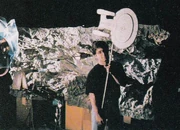 |
 |
As one of the most important hero models of modern televised Star Trek, it came as no surprise that the Galaxy-class studio model had several camera test model counterparts, typically made of styrofoam, for pre-visualization purposes by camera teams. As filming models were rarely built in scale to each other, the Galaxy-class had more than one of these, scaled to whichever model of the week it was supposed to interact with, among others one to interact with the Deep Space 9 studio model during pre-production of "Emissary". In post-production the shot of the test model was replaced with a shot of the four-foot studio model.
Several of these camera test models were sold in It's A Wrap! auctions, one, measuring 10 × 7 × 1.25 inches, as Lot 8421(X) on 2 August 2008 for US$455.00 (resold as Lot 8843(X) on 19 September 2008 for US$394.00), and a second one, measuring 23.25 × 17.5 × 3.25 inches, as Lot 9624(X) on 12 August 2008 for US$127.50.
CGI models
 |
 |
 | |
Realizing during the pre-production stage that the new show would be the most visual effects laden television production of its time, much like its predecessor was, producers Robert Justman and Edward K. Milkis looked into the feasibility of applying CGI to the new television show, especially for exterior ship shots. They even had an effects company compile several test shots for evaluation. Justman recalled, "Eddie Milkis and I investigated the possibility of generating everything on the computer. We had great reservations about it, because it still didn't have the reality. The surface treatment wasn't totally believable [remark: Justman is referring to a CGI Constitution II-class that was commissioned for evaluation, serving as a stand-in for the yet-to-be designed new ship]; we could have gotten by, it would have been acceptable, but it wasn't satisfactory." (Star Trek: The Next Generation USS Enterprise NCC-1701-D Blueprints, booklet, p. 14; Cinefex, issue 37, p. 10) Milkis declined the prospect of adopting CGI for another reason. He commented, "It was incredibly good, and it took some real thinking on our part, but ultimately we decided that if something ever happened to that company and they couldn't deliver, then we'd have nothing. We were very concerned about that and ultimately they did go out of business." (Star Trek: The Next Generation Companion, 3rd ed., p. 11) The earliest known representation of a Galaxy-class vessel as a CGI effect was a crude wire-frame model of the Enterprise-D constructed at Santa Barbara Studios in post-production for compositing a shot in "Masks", where the Enterprise-D frees the D'Arsay archive from the comet. Though the comet and archive were eventually executed as CGI effects, the Enterprise-D was not, stock footage of the four-foot model was composited into the scene instead. Still, when the 2014 remastered version came along, CBS Digital recreated the entire scene in CGI as the original computer files for the archive were no longer available [61], on the occasion also making use of the digital Enterprise-D model they had available for such occurrences. [62]
No production CGI version was ever built for the The Next Generation television series, though Effects Supervisor David Stipes, at the time the foremost advocate of application of CGI, eagerly wanted and lobbied for one:
"On "The Chase" we were all over the galaxy-warp here and warp there-and I have basically the one or two jumps to warp that we had in stock. When TNG was started, the first bits of material were shot at ILM and they shot the original jump to warp with slit scan and streak photography. That served us very well for seven years, but it was very difficult to do and expensive. I had been pushing to build a CGI Enterprise, but no one wanted to incur the expense at that point so I lived with the stock shots." (Cinefantastique, Vol. 27, issue 4/5, p. 79)
ILM's CGI model
 |
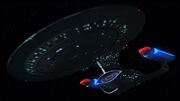 |
When ILM's Visual Effects Supervisor John Knoll discovered how well the just constructed CGI model of the USS Enterprise-B translated on-screen during the production of Generations, he decided to have a CGI version of the Enterprise-D built as well for scenes where the ship jumped to warp:
"So I did the two shots of the Enterprise-D going into warp on the feature. The original effect was done using motion control and slit-scan, which was really the only thing that was practical at the time. The problem with slit-scan approach, which involved projecting a slit of light onto the model from front to back, was that we couldn't have rim light, all the light had to come directly from the side, and we couldn't do slit-scan on a light pass. If you analyze the warpdrive stretch in the TV show, you'll notice that the portholes go off as soon as the stretch starts! It worked fine for what the TV show intended to do, but today it just barely holds up, even on television. "When we were faced with doing the same for the feature, I figured we should use computer graphics, which would allow us to do the effect the right way-the ship could stretch out, its blinkers could keep going and the lighting wouldn't change. Admittedly, back in 1987, we couldn't really do a completely realistic CG Enterprise that looked as good as the motion-control model, but I think we achieved that this time. Basically, we took a CG model of the Enterprise-D and just snapped it into warp drive. It's easy enough." (American Cinematographer, April 1995, pp. 87-88)
On another occasion Knoll further stated:
"The original animation for that effect was all 2-D, so the nacelles didn't really occlude the light effect as they would have in reality. This time out we made sure they did, by creating a CG Enterprise and stretching it. As a result the ship's clear definition during the jump to warp speed has much greater presence. The ship really stretches, and the internal lights remain on throughout the effect since there is no abrupt jump to different model."
As to the starburst when the warpdrive is engaged, he continued, "I designed it to have a little more motion; and the way the flare tapers and fades makes it look more like an actual light. It's a similar look to previous warp entries, but more polished." (Cinefex, No.61, p.70) Knoll took on the task of building the CGI model himself at his home in his spare time (using flat-lit photographs taken from the refurbished six-foot studio model for mapping), and rendered the model in the ElectricImage 2.1 software package. (Cinefex, issue 61, backcover)
Knoll used a low-resolution CGI version of the Enterprise-D and the Duras sisters' Bird-of-Prey for story-boarding and animatics purposes. (The Art of Star Trek, p. 285)
Digital Muse's CGI model

During the pre-production of sixth season of Star Trek: Deep Space Nine, it became clear that events would lead up to the massive climactic battle in "Sacrifice of Angels". Visual effects supervisors were aware that that battle was impossible to realize using traditional motion-control photography. "The problem is that motion control is about shooting one ship at a time, one pass at a time. There was just no way we could have done it. We just didn't have enough time or money", David Stipes explained. (Star Trek: Deep Space Nine Companion, p. 501) In order to execute these scenes, it was decided to complete the transition to CGI. Due to the scale of the project it was decided to divide the workload up between Digital Muse, who were to transform the Federation starships to CGI and Foundation Imaging who were responsible for the alien ships.
Part of the process was the decision to greatly improve efficiency by employing one software format only, LightWave 3D. This entailed turning over existing CGI models, done in other software formats, to Digital Muse for re-programming and re-rendering in "LightWave". This included the ILM models done for Star Trek Generations and Star Trek: First Contact. Digital Muse's supervisor Bruce Branit elaborated:
"It was the first time that anyone had actually assembled the entire Starfleet fleet in CG. Normally there were always a few ships they used for CG, and they pulled models out, and did motion control. Due to the nature of the show, there was no way they could do it with motion control. There was not enough time and not enough money. They were talking about having fifty to a hundred Starfleet vessels on screen at one time, and there was no way to pull that off in traditional ways. So we were a collecting point for anything that had been done in CG before. We brought the digital models in and converted them to LightWave, which is our rendering package of choice. The Enterprise-D had been done before, but in something else, so we were able to bring the geometry in, and bring some of the maps in, but we had to rebuild it. We had all the ingredients, so we could put it together much more quickly than building it from scratch. So now we have folders with the entire fleet all lined up in the same form, so we can just load a Reliant, we can load a Defiant, we can load an Excelsior, whenever we need it. That was the first real challenge, to get all that stuff in order, and to fill the garage with usable ships." (Cinefantastique, Vol.30, issue 9/10, p. 64)
Part of the upgrade was the re-mapping of the model with newly taken flat-lit photographs of the physical studio model. As Digital Muse had only the four-foot model at their disposal as reference, their model was endowed with the color scheme of that model, light blue-gray with duck-egg blue highlights, instead of the color-scheme re-applied to the six-foot model at ILM. (Sci-Fi & Fantasy Models, issue 32, p. 55) In this guise the CGI model debuted prominently as Galaxy-class article illustrations in Star Trek Fact Files (its editor-in-chief Ben Robinson having as the first realized that production-used CGI models were singularly well suited for print reproductions as well [63]), additionally appearing in Star Trek: The Magazine, and most specifically in Star Trek: The Official Starships Collection. The Enterprise-D model was one of the very first tackled by Digital Muse and could already be showcased in the earlier episode "Call to Arms" and remained in use throughout the remainder of the Deep Space Nine and Voyager series. [64]

Long after Deep Space Nine and Voyager had wrapped, Digital Muse's model made one last reappearance in another official live-action production, when it was featured in the opening scenes of the film portion in the 2004 Borg Invasion 4D-ride at the Star Trek: The Experience-attraction. Former Foundation Visual Effects Supervisor Adam Lebowitz was now serving in a similar function at Threshold Digital Research Labs for this film and had access to the digital database of previously used CGI live-action production starship models. Several of these featured, mostly as scenic backdrops in the opening and closing scenes.
Gabriel Koerner's CGI model

The Enterprise-D was to make one more prominent appearance in the 2005 Star Trek: Enterprise finale "These Are the Voyages...". However, as the series was shot in HD, as opposed to the previous series that were shot in SD, new footage of the Enterprise-D was called for. Since motion-control photography of physical studio models was no longer an option, that left the producers with the options to either build a brand new CGI model or use Digital Muse's model. Budgetary considerations prevented construction of a new model, so an upgrade was performed on the existing Digital Muse model. Gabriel Koerner volunteered to do the upgrade:
"The Generations model and the DS9 / VOY model are the same. However its really low poly. The only reason they were able to get it to look so nice in Generations (it appears in the warp-jump shot right after stellar cartography scene) is that it was mapped with photos of the miniature. However it was lit VEEEERY carefully to not expose its flaws. Remember, DS9 and VOY were also mastered at standard def, Enterprise at HD. It needed to perform more dynamically, we needed to see the specular highlights rolling across it (the simpler model had to be lit more flatly), and generally see more detail, as the miniature photo texture maps were not very high resolution. So now we had a model that, instead of cheating and being able to do only limited things with, could really give a performance. The budget only warranted upgrading the existing model, I was working at Eden at the time and did the model in my spare time. I was paid the budget allocated to up-res the old model, but that wasn't much so I basically did it for a song and a dance. BUT the consolation is... that model is in the final shot of 18 years of modern Star Trek... too bad everything before the final shot is unwatchable." [65](X)
Explaining his thought processes behind the upgrade, Koerner further clarified:
"I modeled it and textured the saucer and nacelles. I took some liberties. As many know there were two miniatures: The initial ILM smooth 6 footer (which in my opinion was the more graceful of the two) and the chunkier, thicker paneled 4 footer. I gave it the lines of the 6 footer, about half the thickness of the paneling from the 4 footer, the thicker lifeboat hatches of the 4 footer, and the shinier highlights of the Generations repaint. A notable difference is that because of constraints in the model the lights on the rim of the saucer were never seen lit, this is the first time that they are. I hope I got it right. This really was a labor of love... with a check attached." [66](X)
Koerner, who essentially constructed a new build, went on crediting co-worker Benjamin Burnett for helping out rendering the secondary hull due to time constraints. Another co-worker, Robert Bonchune, fondly recalled, "Gabe was sooooooo keen to have his ship in the final. We had one also, but no one objected to using his as he had put so much of his own time work into it and the mesh detail was truly great. I didn't sup the last show, but his stills are really nice. He loves that ship!" [67]
Both Digital Muse's and Koerner's versions of the CGI model went on to make several appearances in and onto licensed Star Trek publications, most notably in the Star Trek: Ships of the Line calendars and their book derivatives, and would have been prominently featured in the abandoned The Official Star Trek The Next Generation: Build the USS Enterprise NCC-1701-D project.
Appendices
Related topics
Further reading
- "Designing the Enterprise", Dennis Fischer, The Official Star Trek: The Next Generation Magazine Vol. 4, April 1988, pp. 29-37
- The Art of Star Trek, November 1995
- "Entertainment Visual Design: A Look Back", Andrew Probert, Starlog photo guidebook Special Effects, Volume 5, January 1996, pp. 88-113
- Star Trek: The Next Generation USS Enterprise NCC-1701-D Blueprints, July 1996, accompanying booklet
- Star Trek: The Next Generation - The Continuing Mission, November 1997
- "Designing the USS Enterprise NCC-1701-D", Star Trek: The Magazine Volume 1, Issue 16, pp. 50-56, August 2000
- Star Trek: The Official Starships Collection
- Issue 1, August 2013
- Issue XL02, June 2017
External links
- The Saucer Rim on the Galaxy-class at Ex Astris Scientia: analysis on the differences in appearances between the older and newer miniatures
- Designing The Next Generation Enterprise at Forgotten Trek
- Designing the USS Enterprise NCC-1701-D, online version at the Federation Starship Datalink
- Creating the Four Foot D at Greg Jein's Shop at Facebook – featuring a behind-the-scenes video registration, currently owned by Doug Drexler, made by Gary Hutzel during the construction of the four-foot model.
